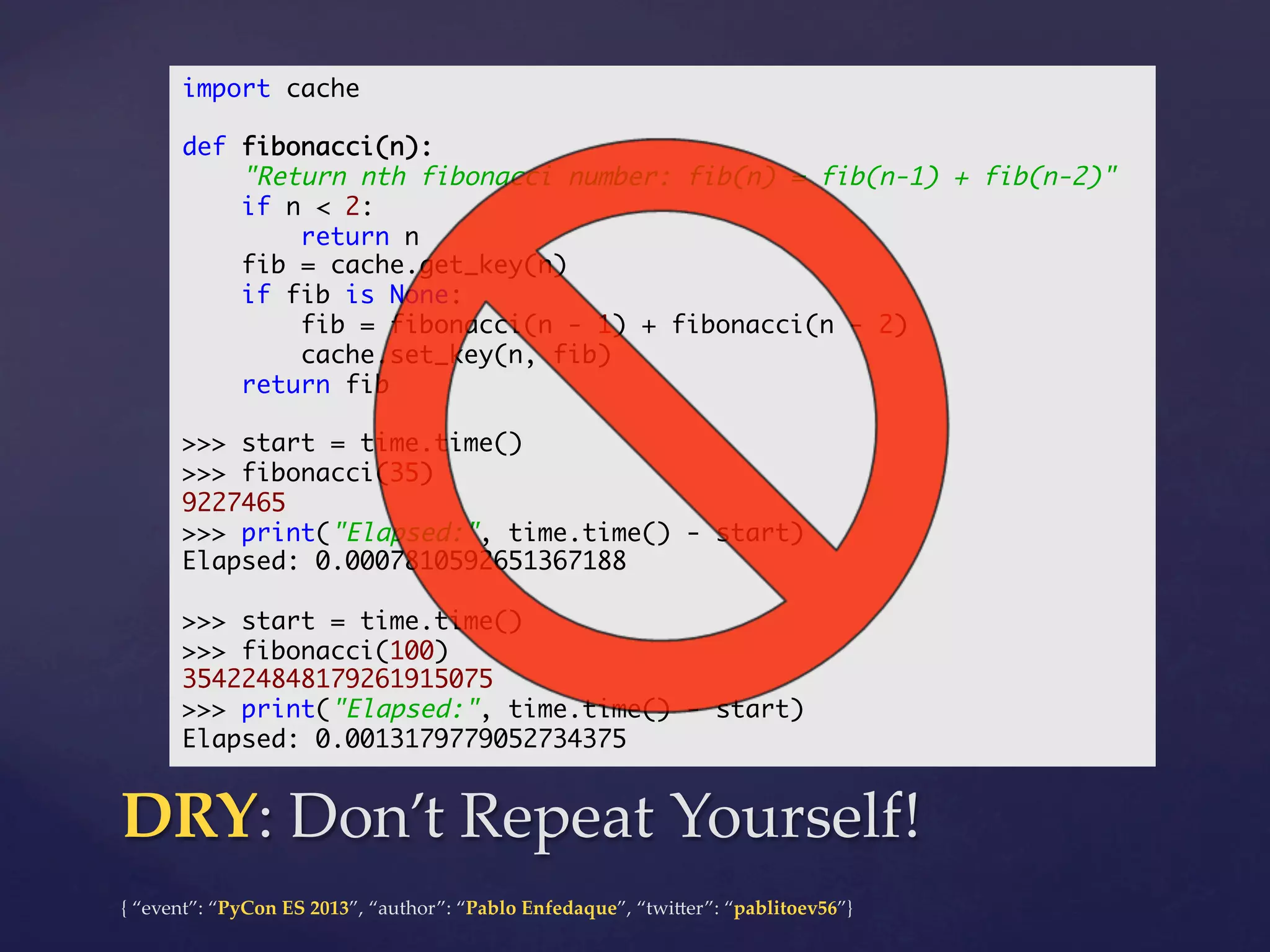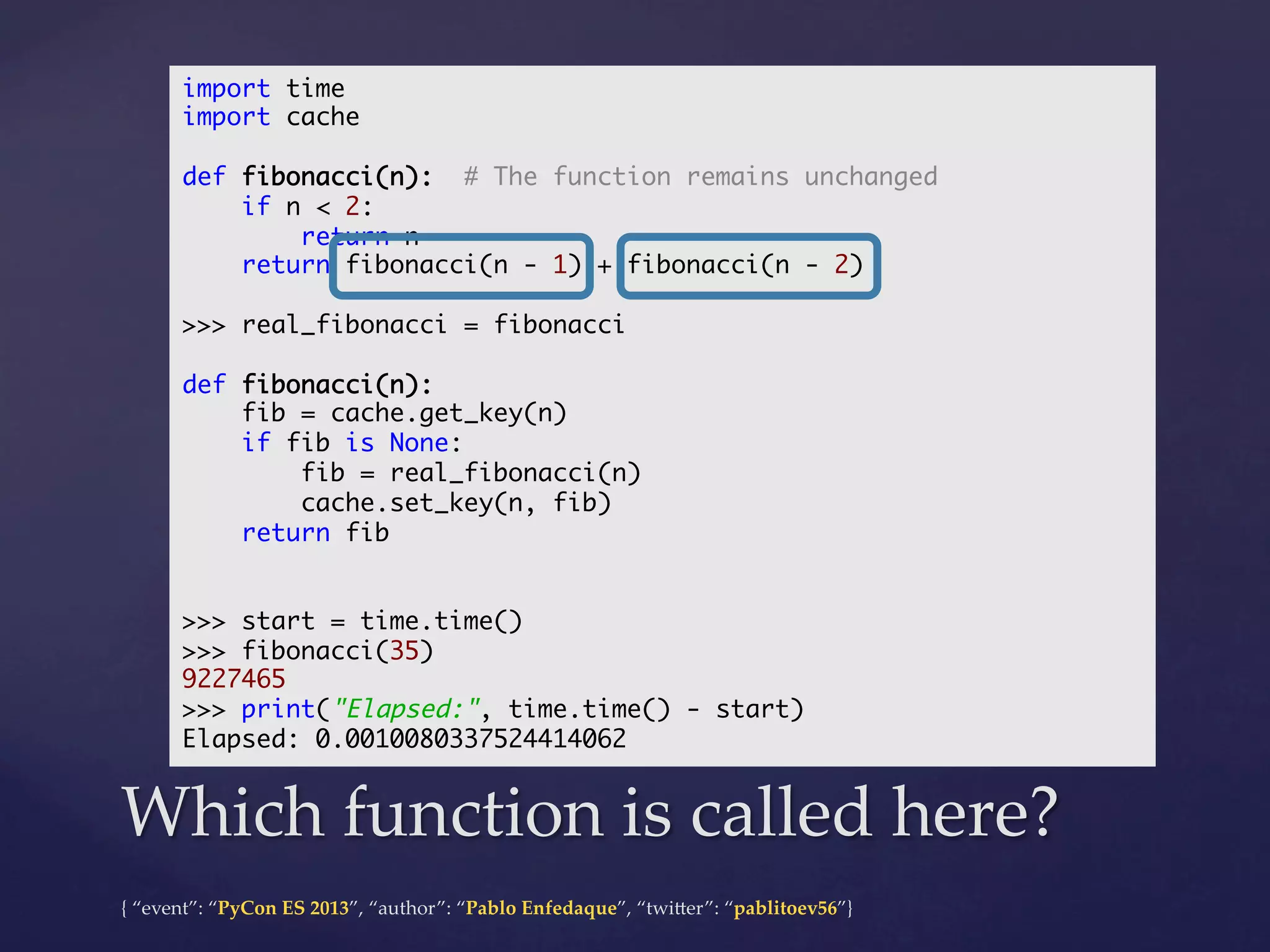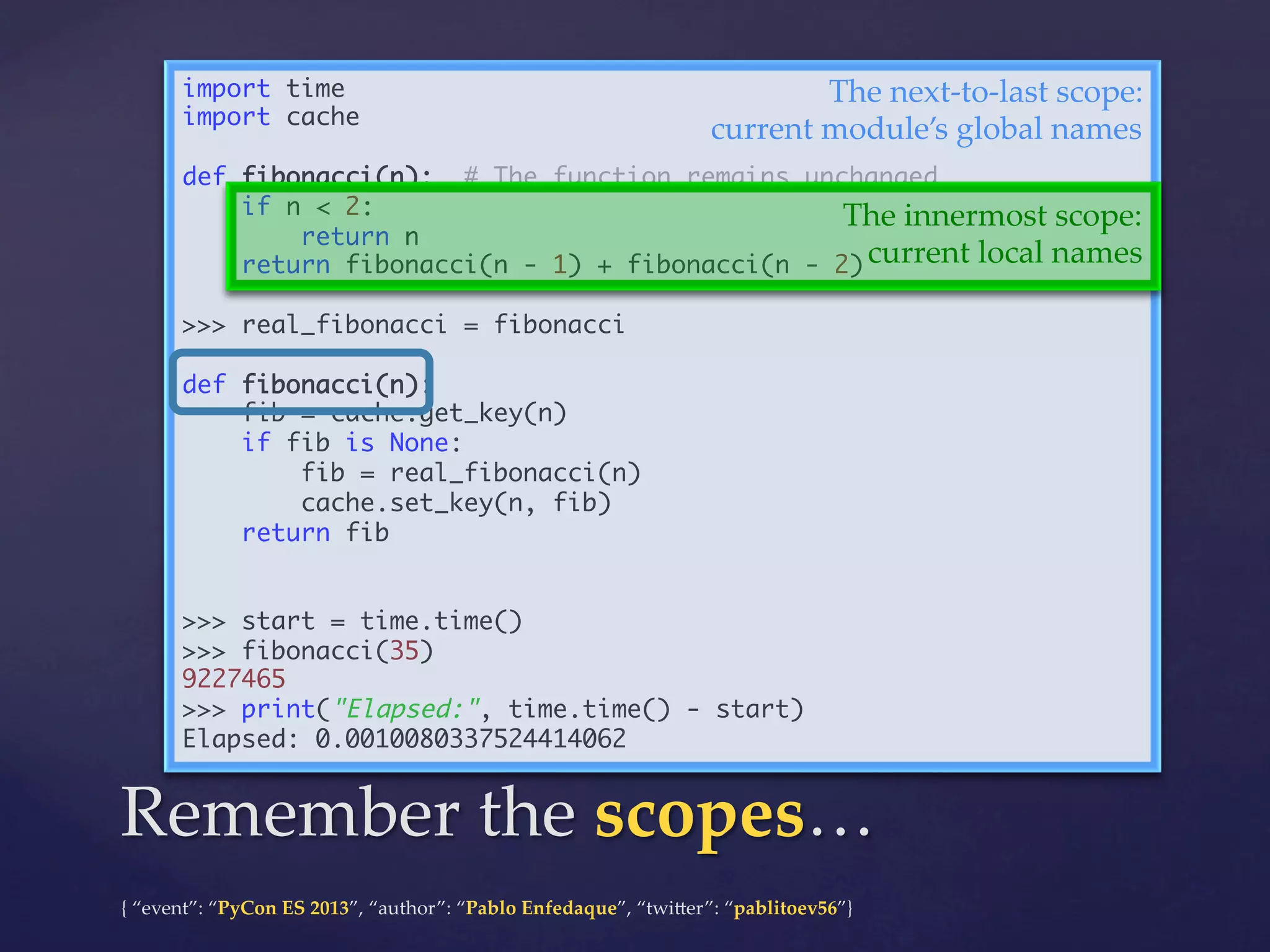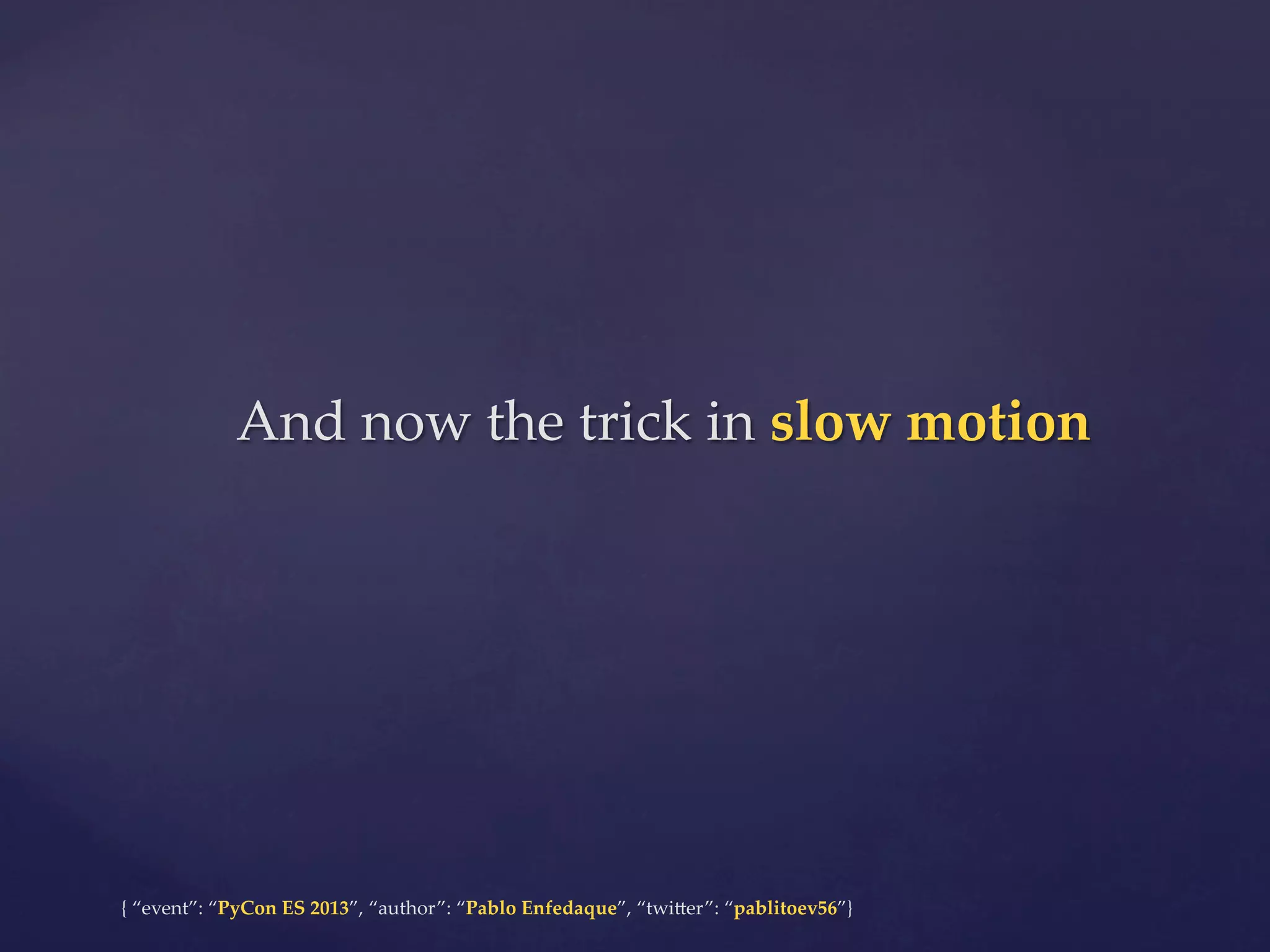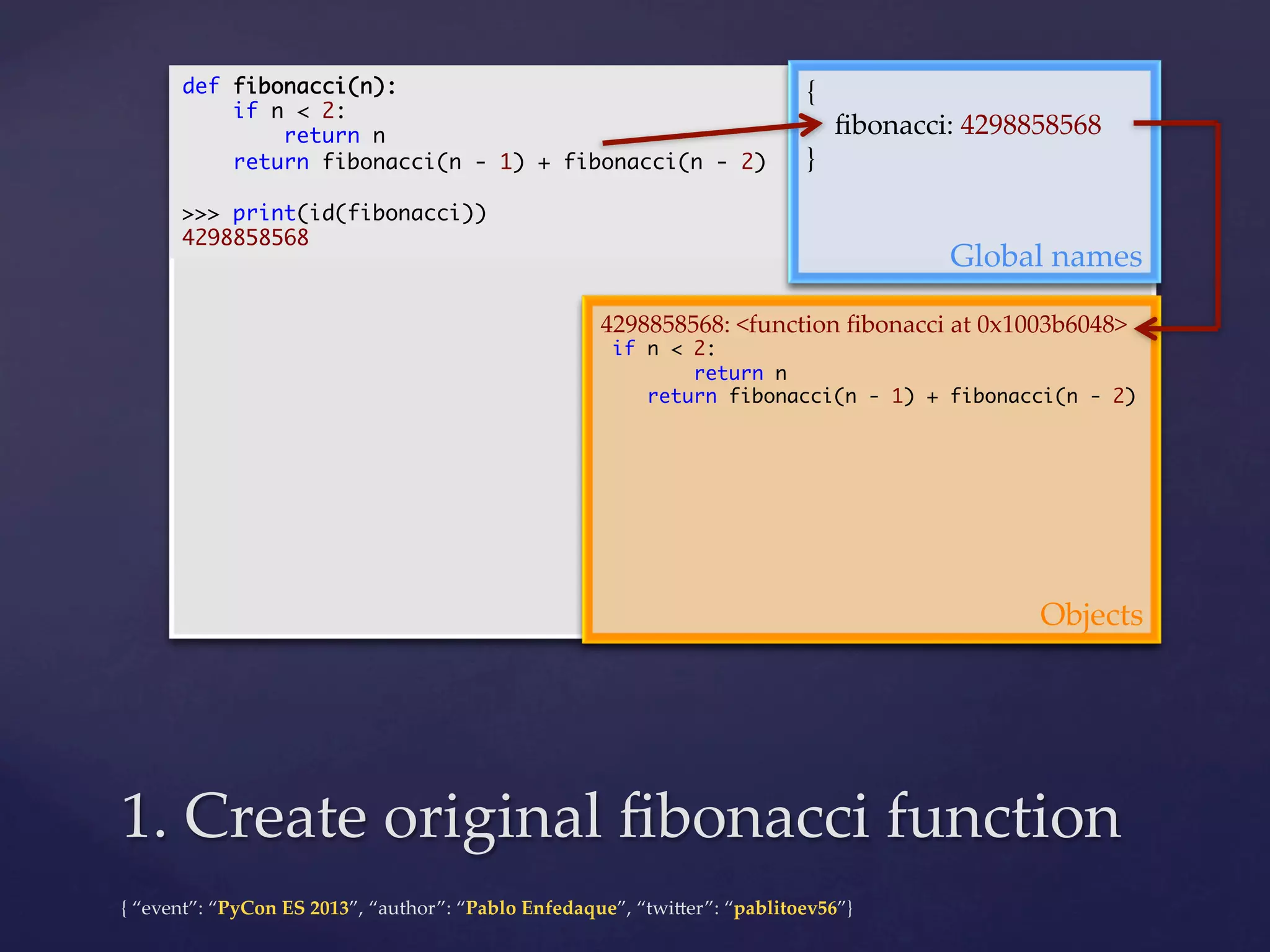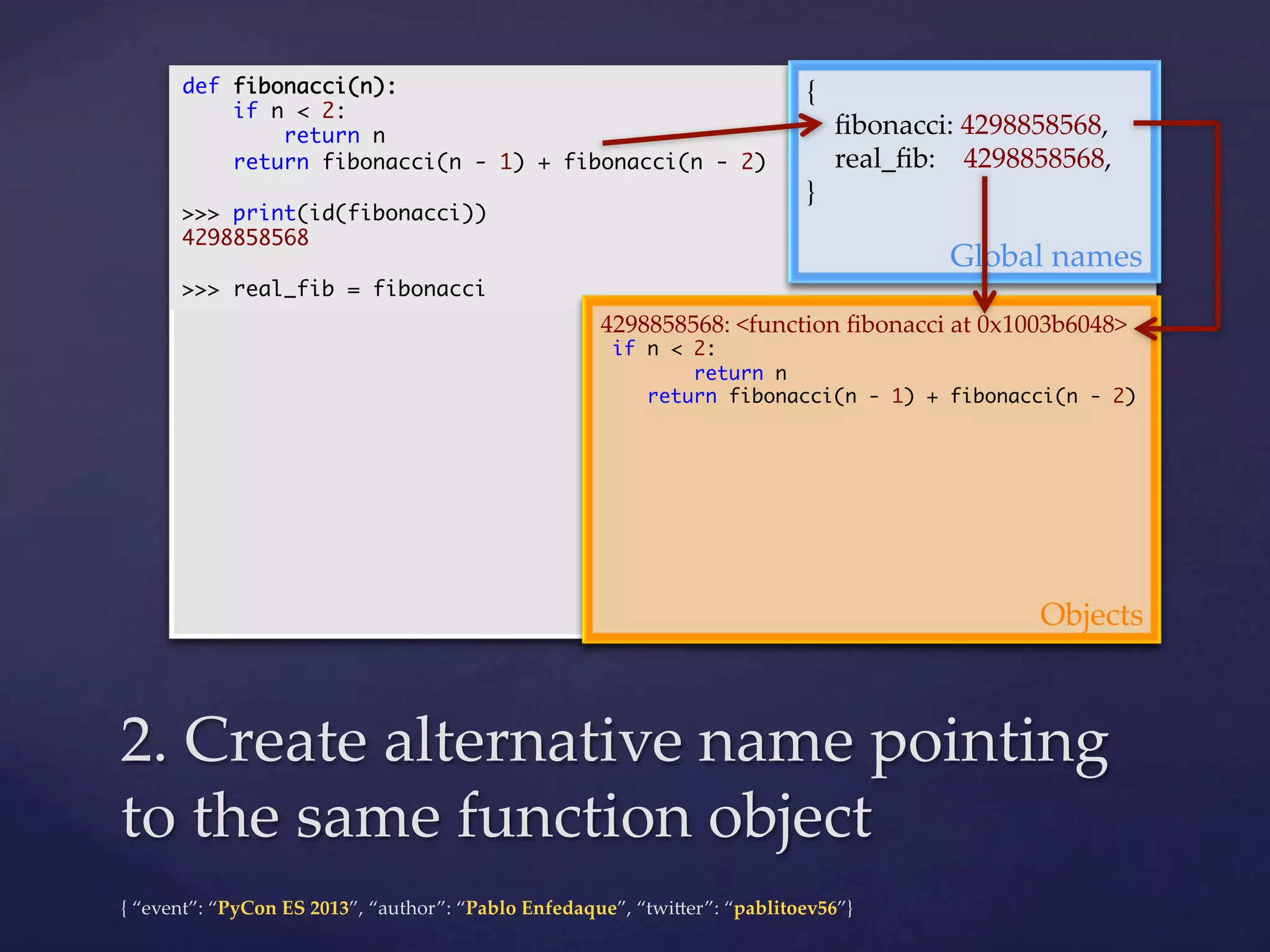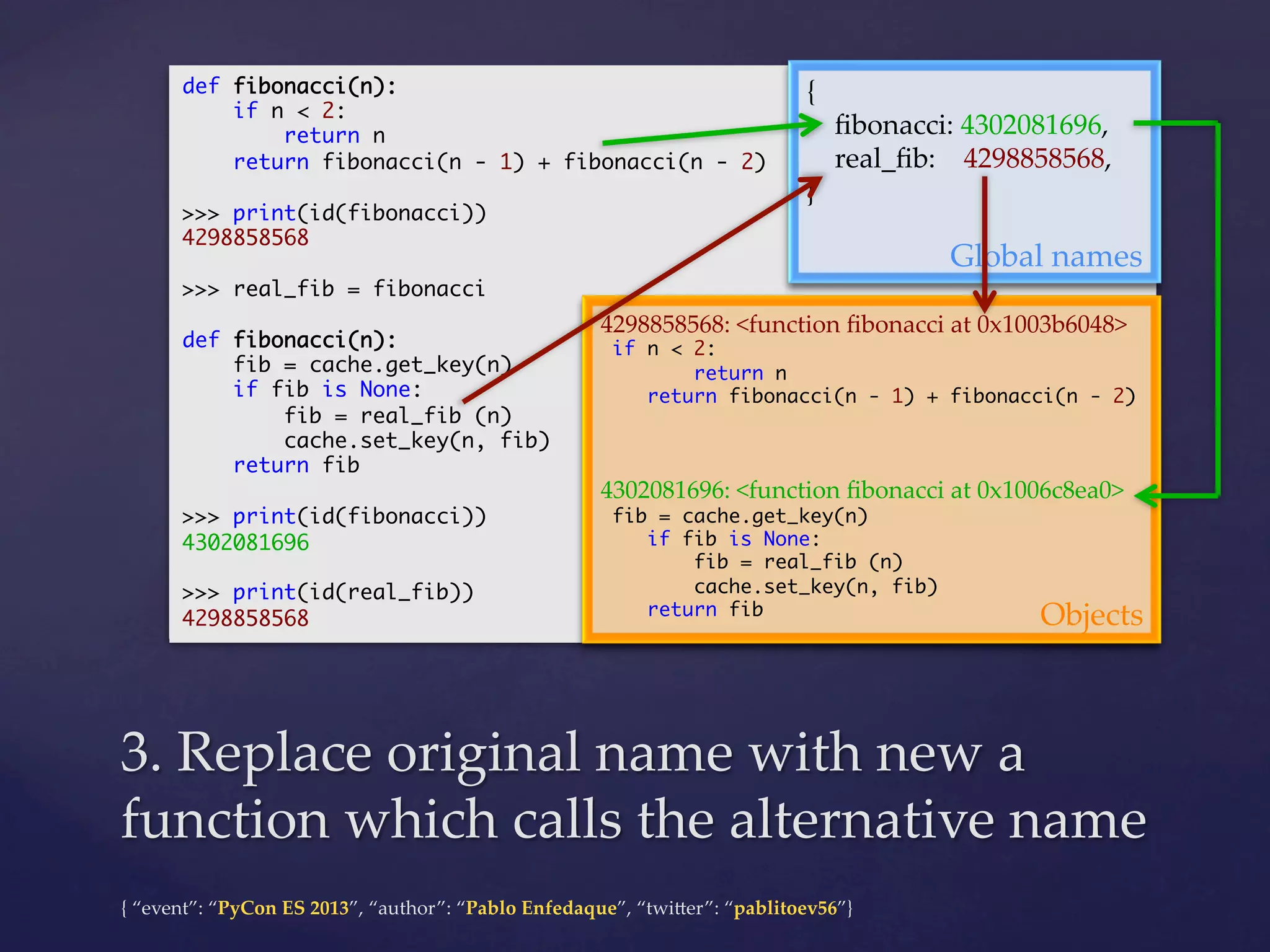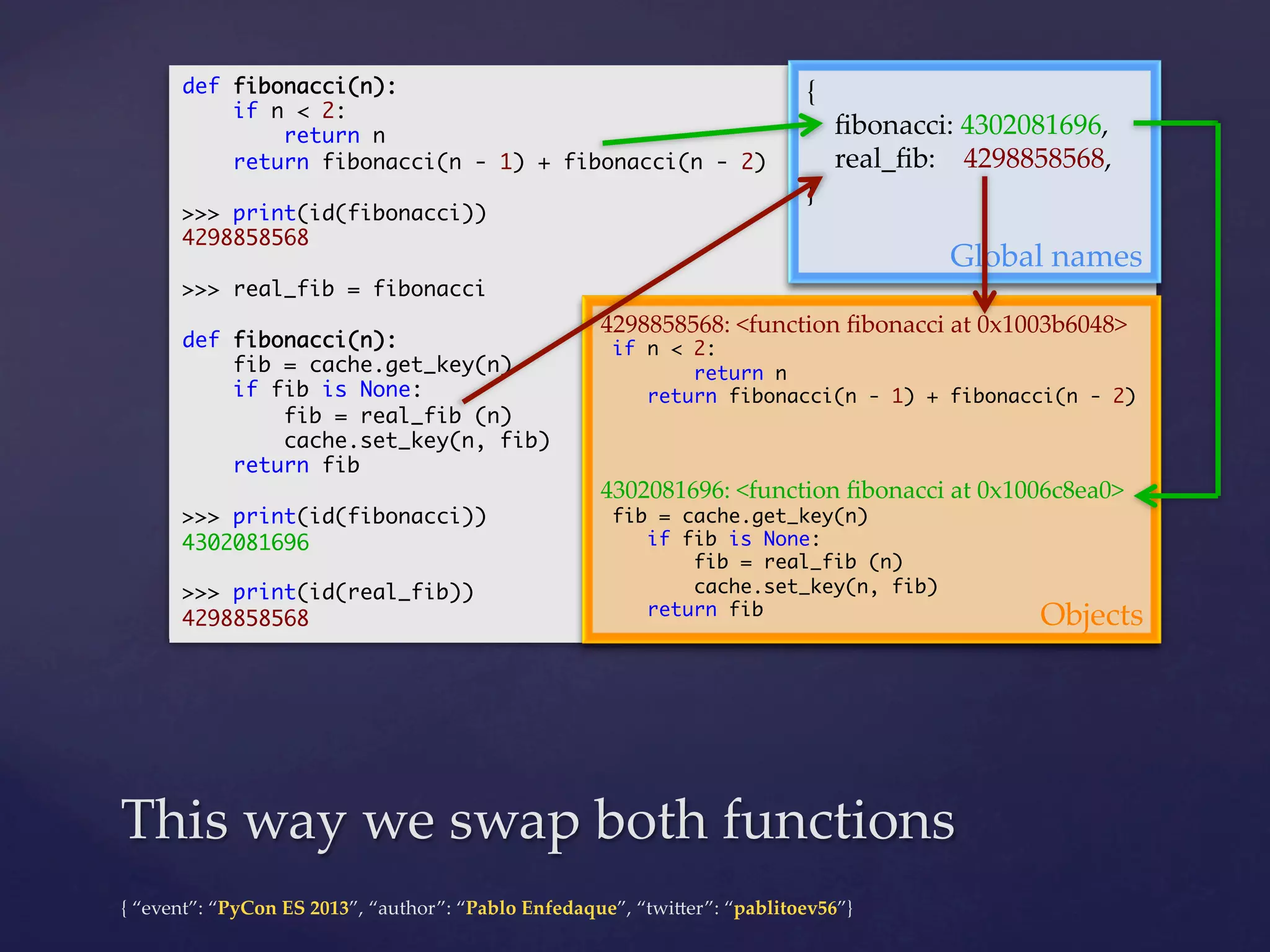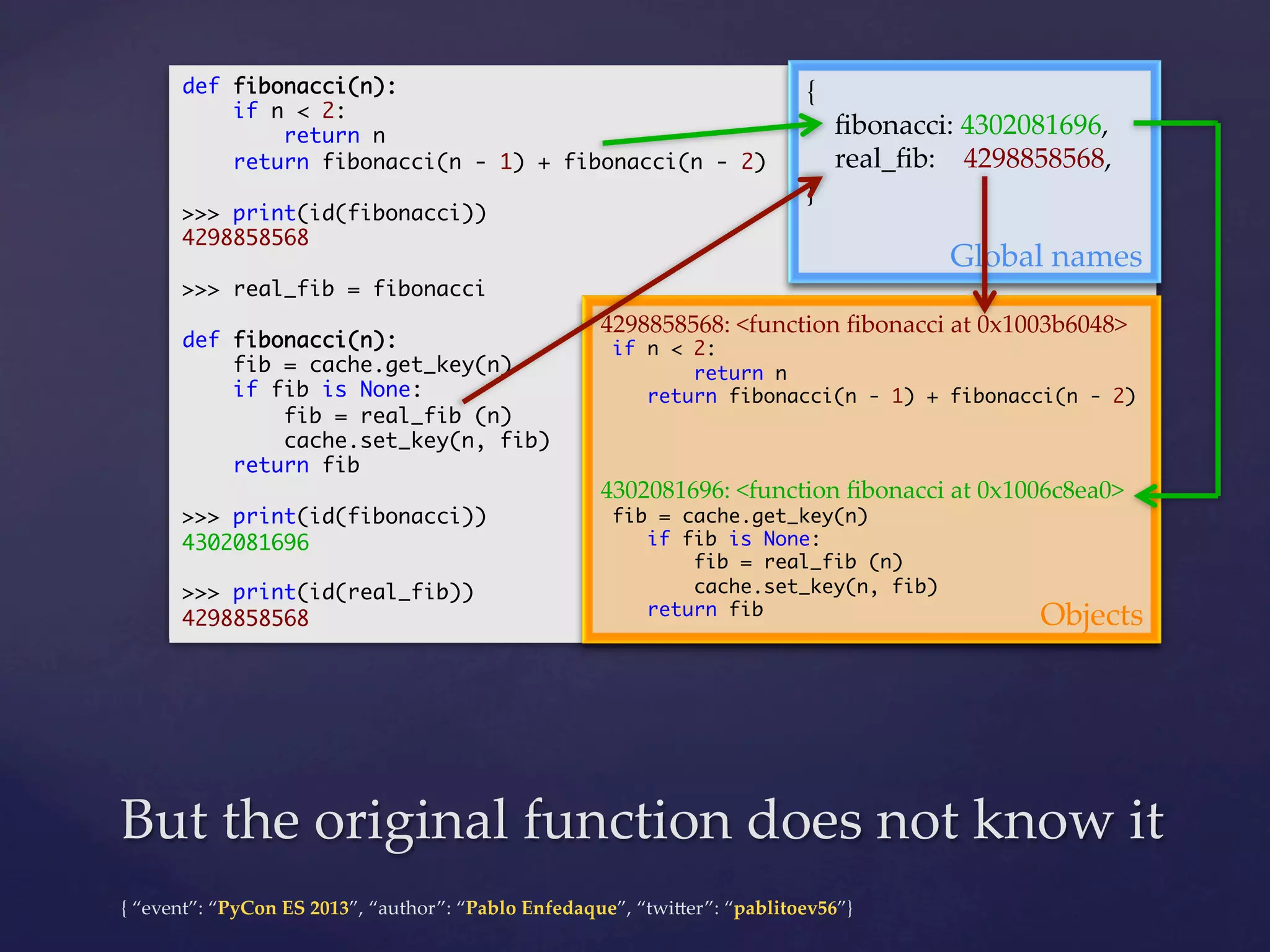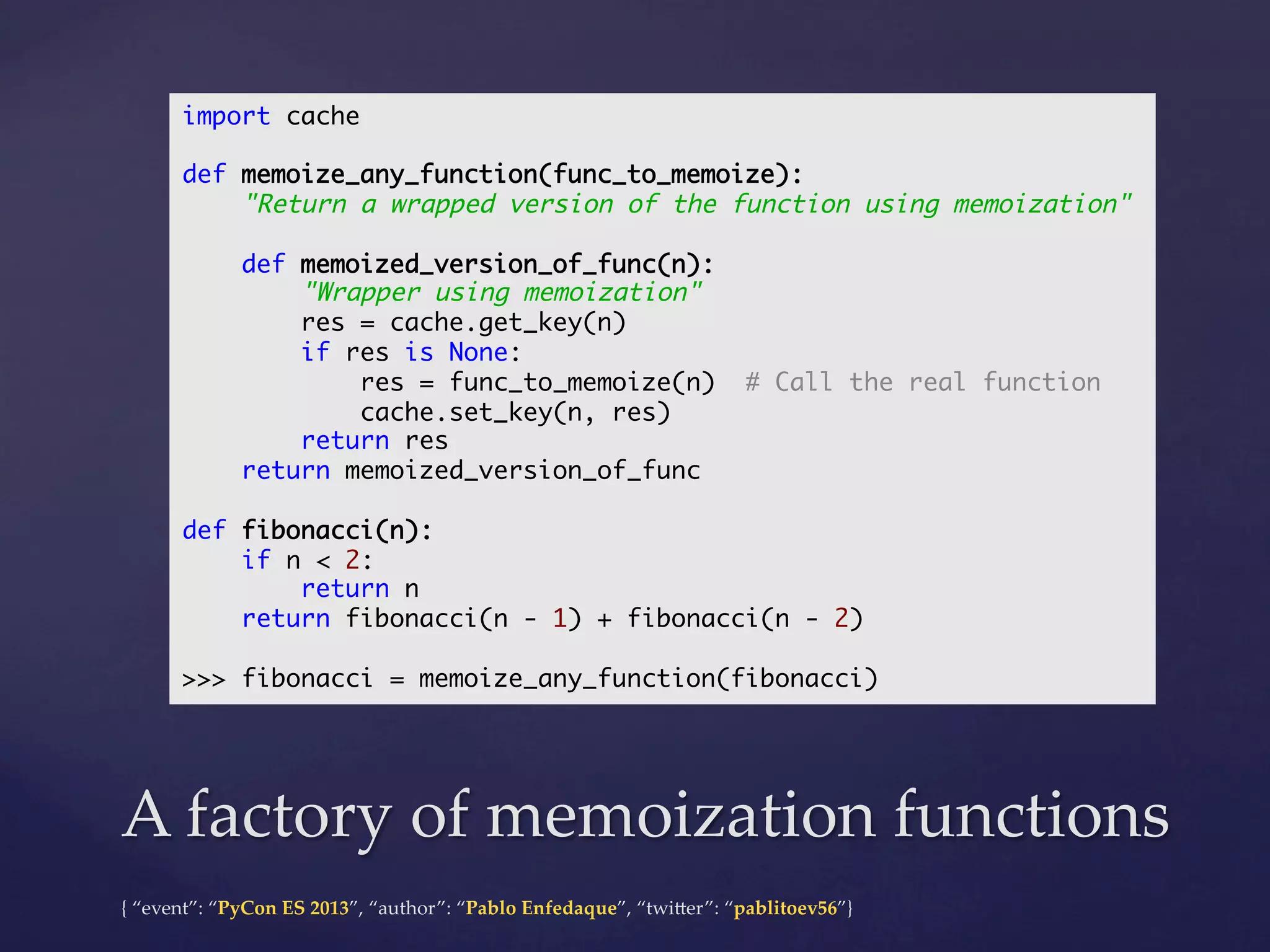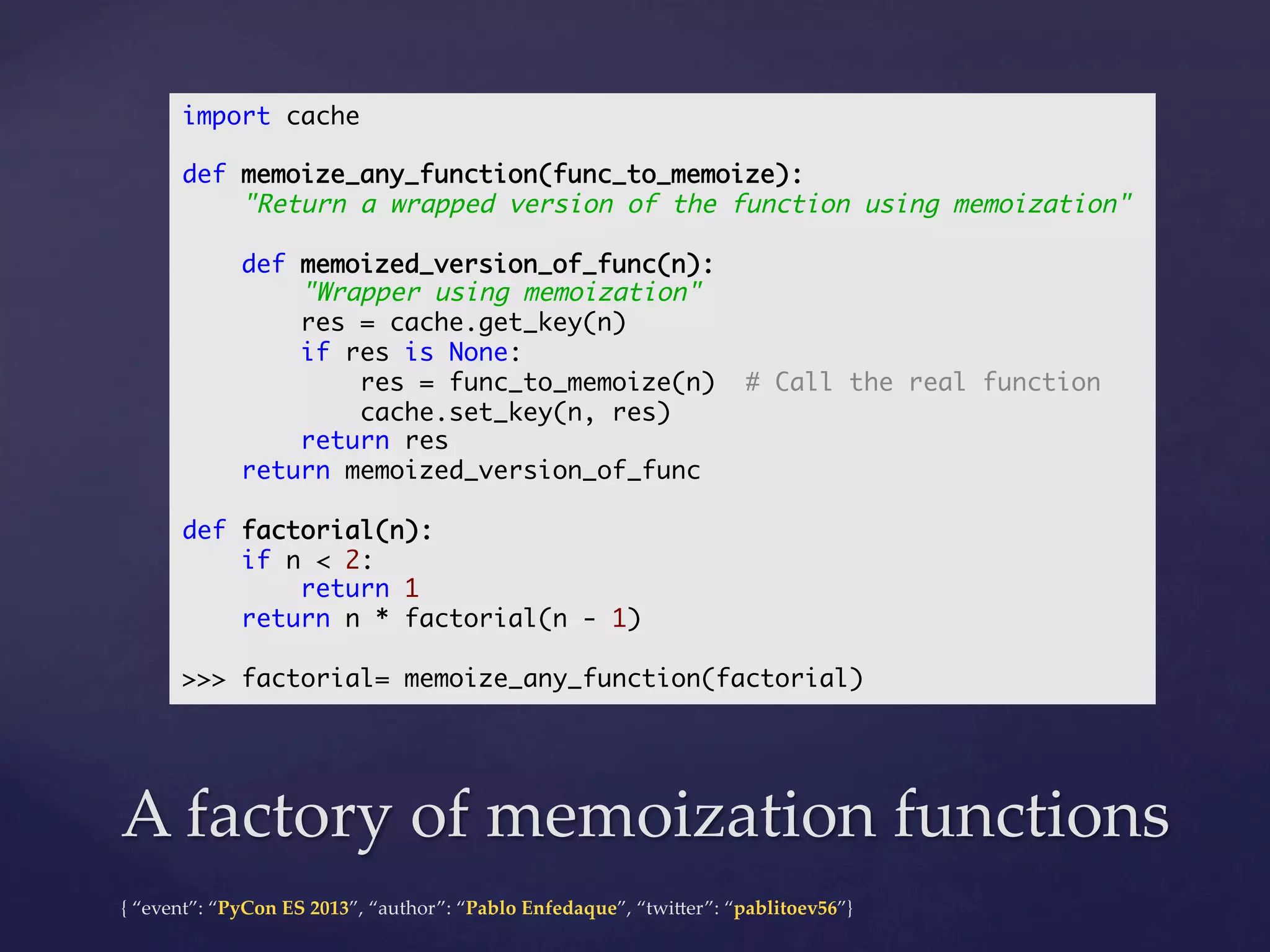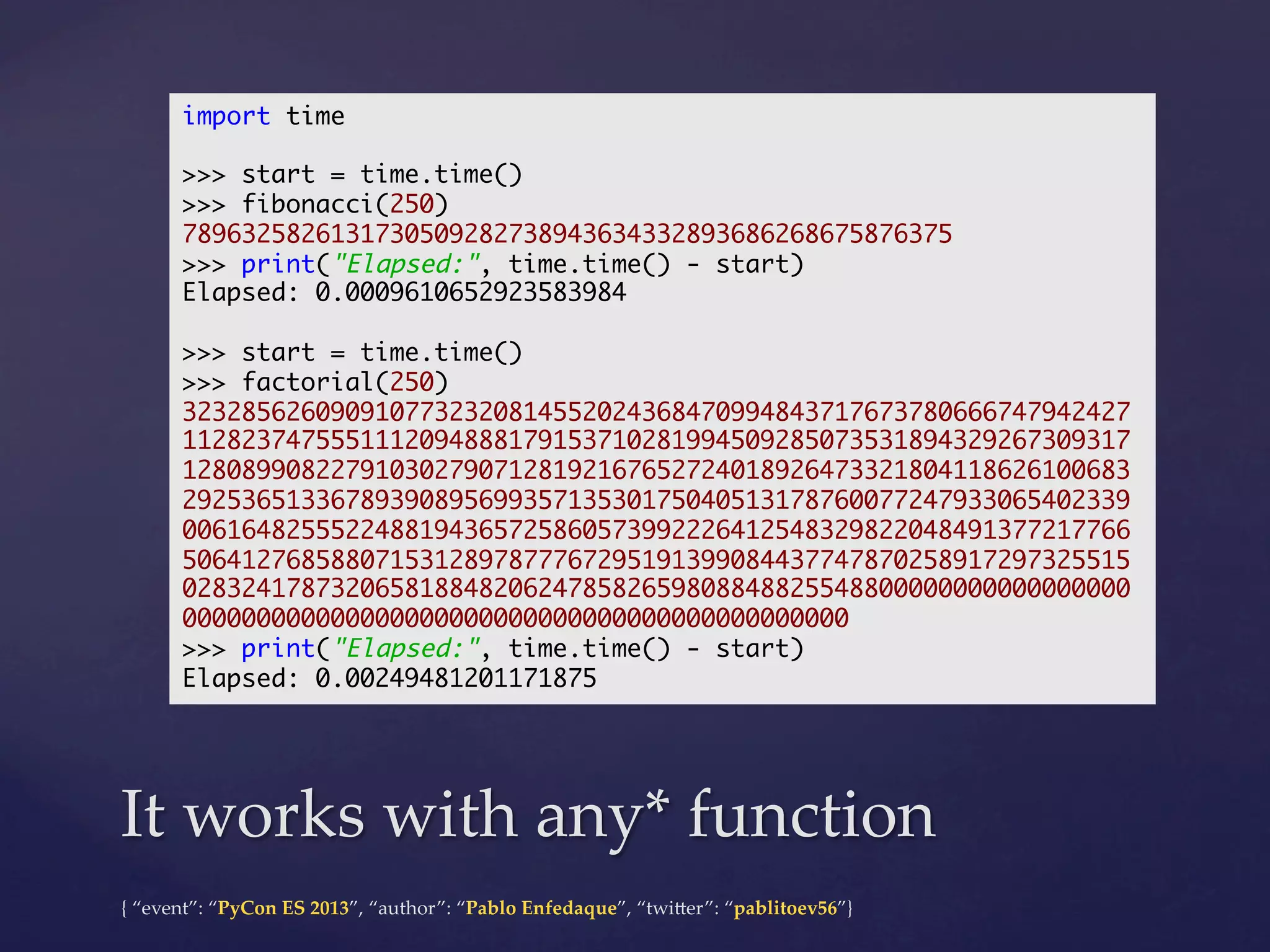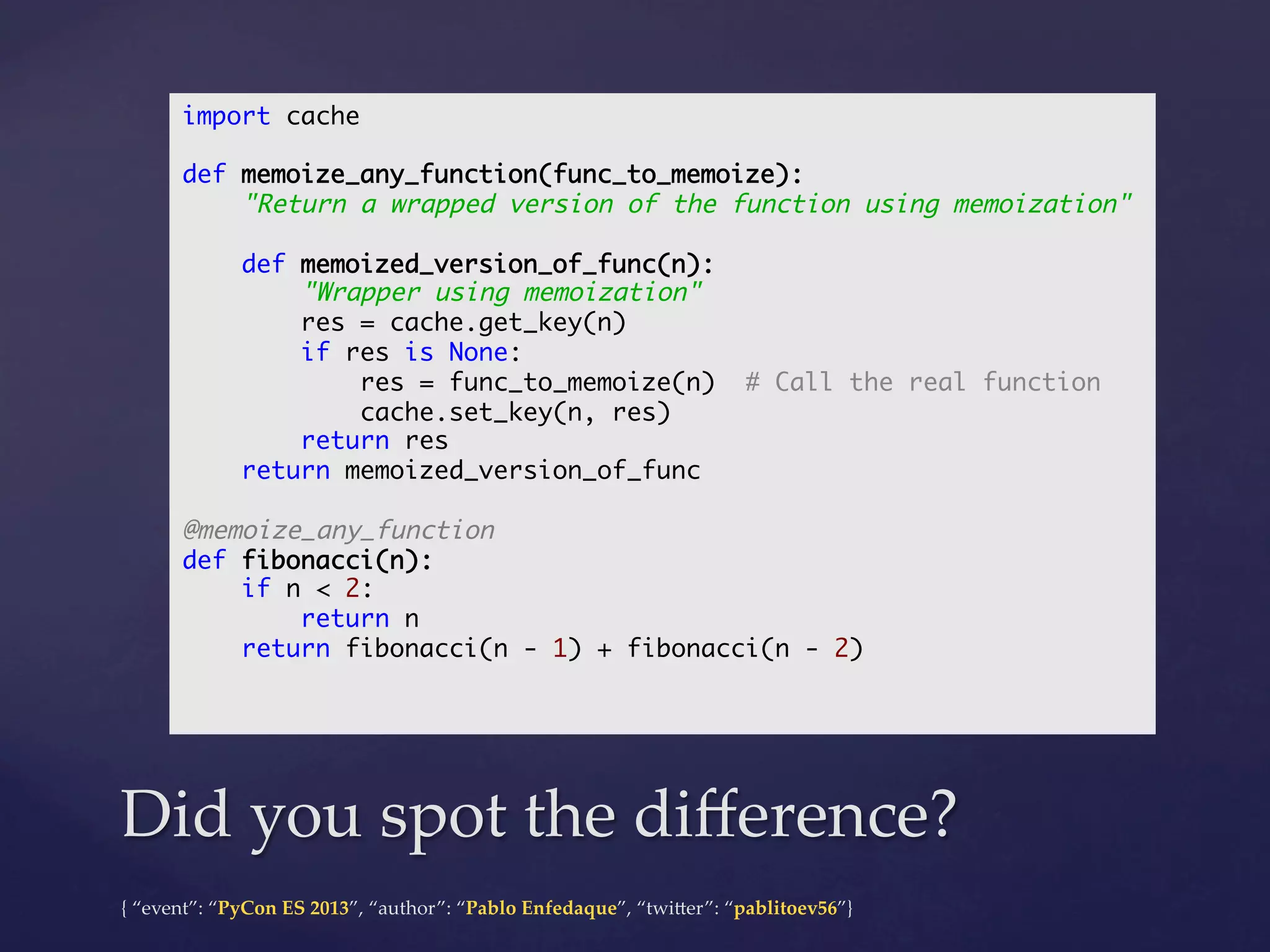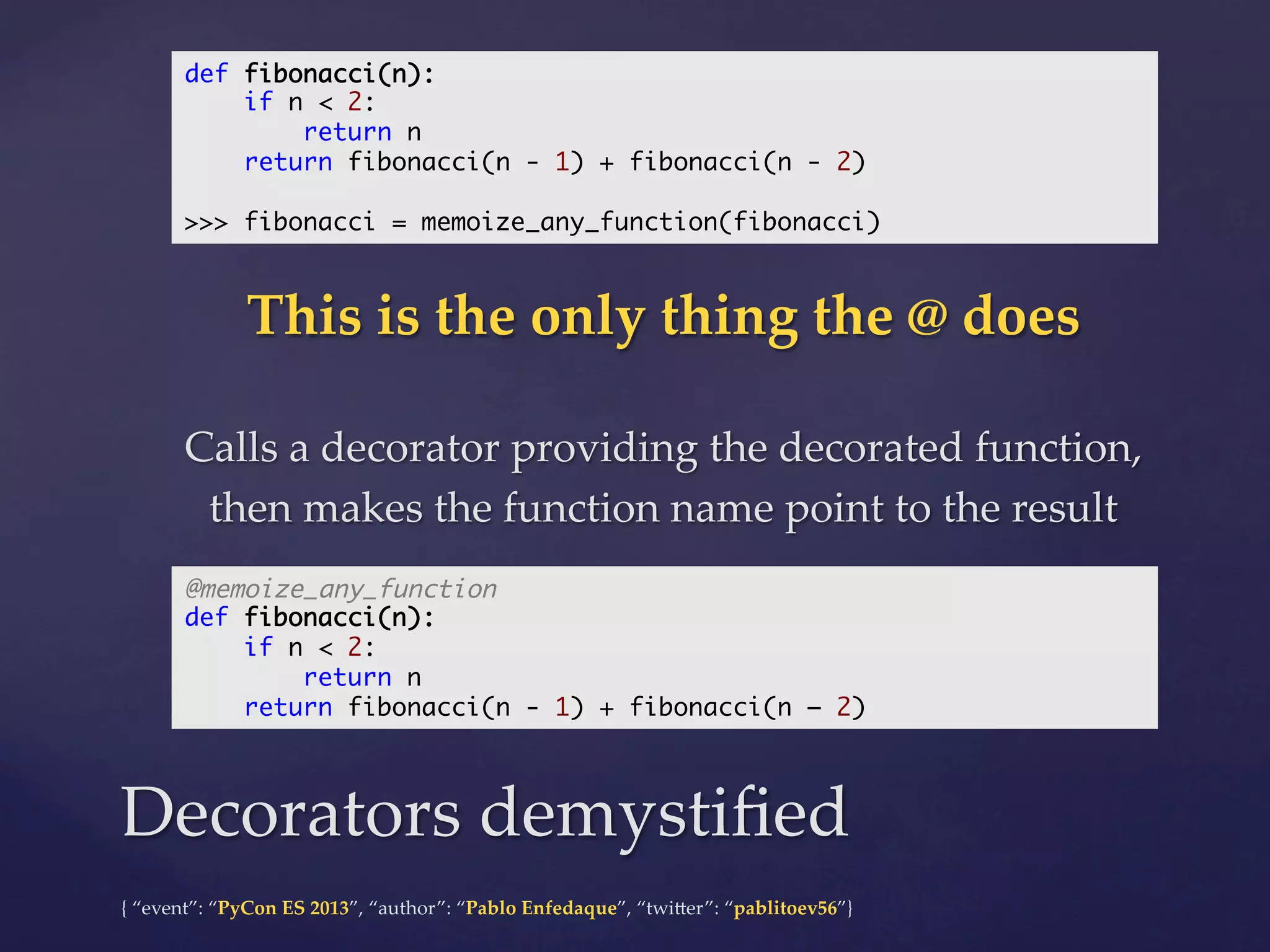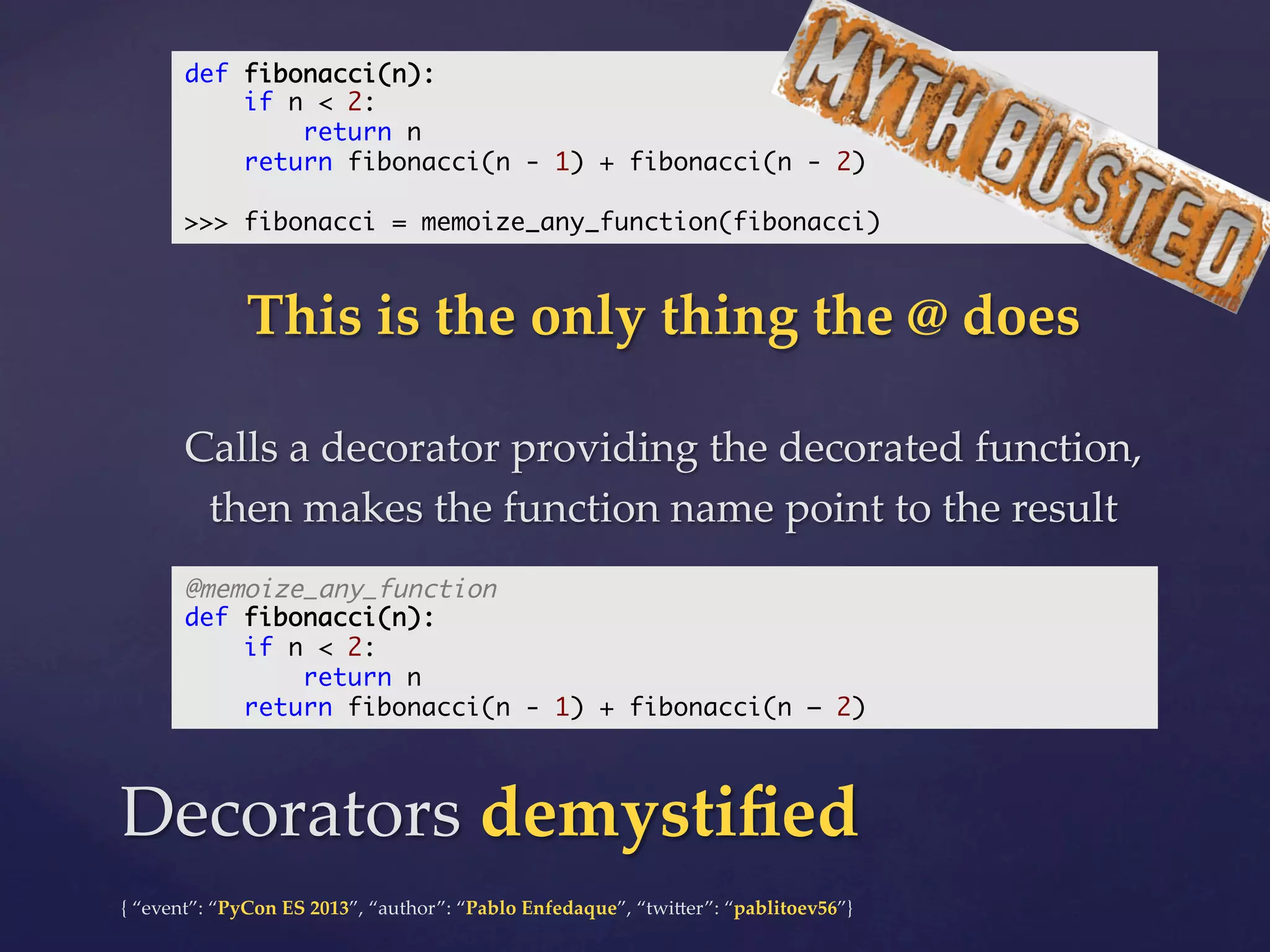The document discusses Python decorators, namespaces, scopes, and closures, primarily focusing on how decorators modify functions and classes. It includes examples like implementing a cache mechanism, factorial and Fibonacci functions, and explains the context of variable scopes with non-local references. The session was presented by Pablo Enfedaque at PyCon ES 2013.
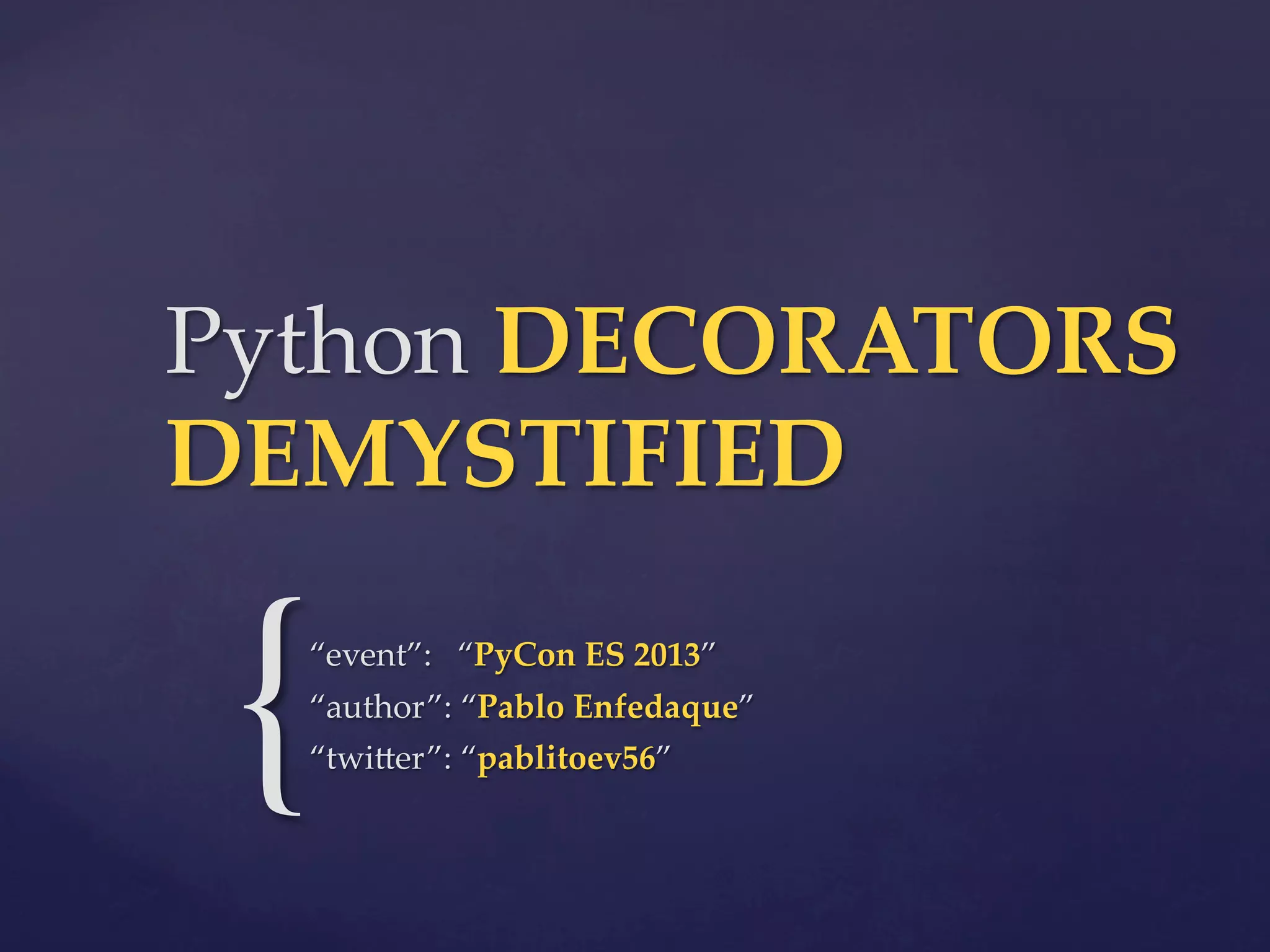
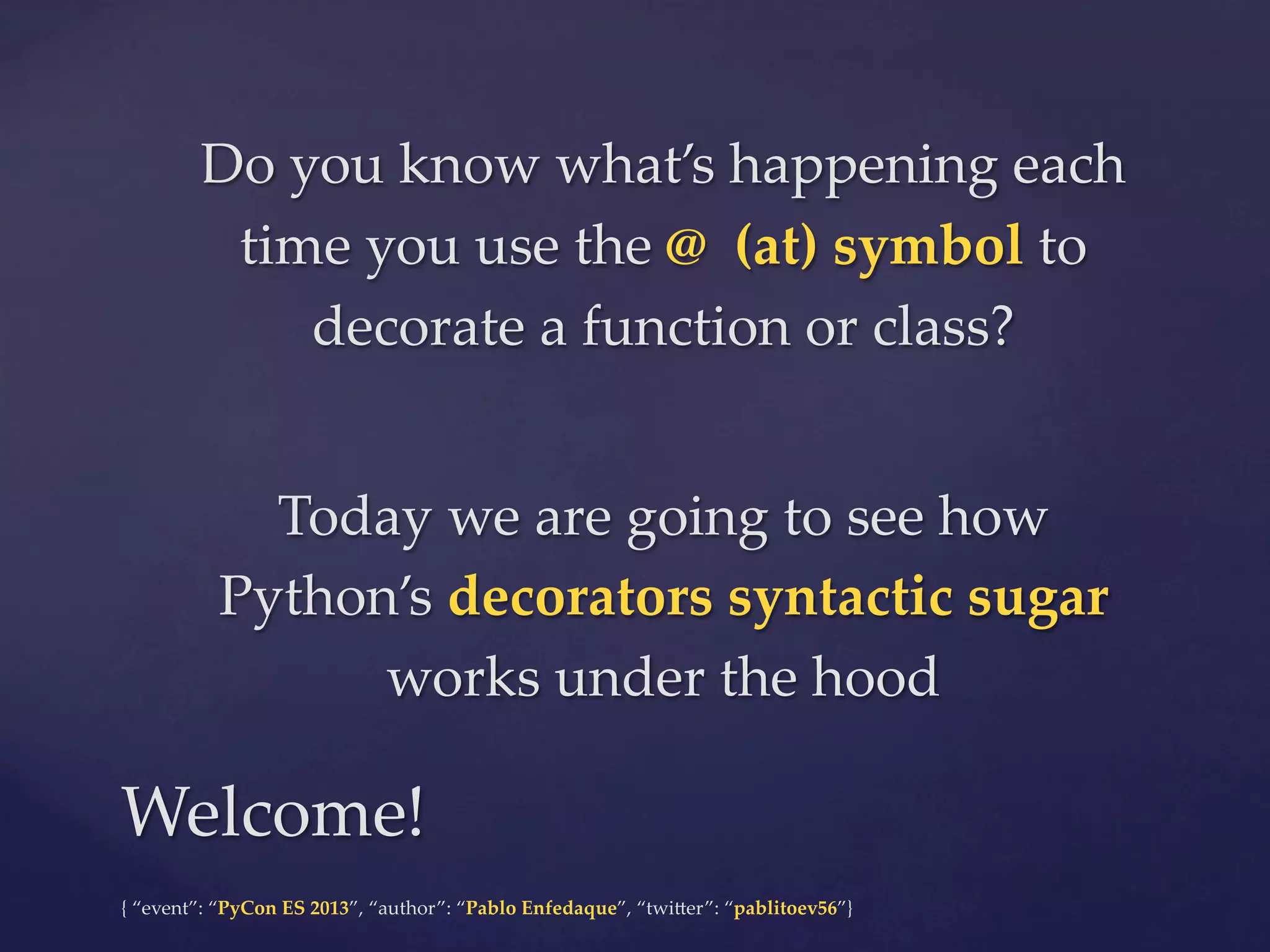
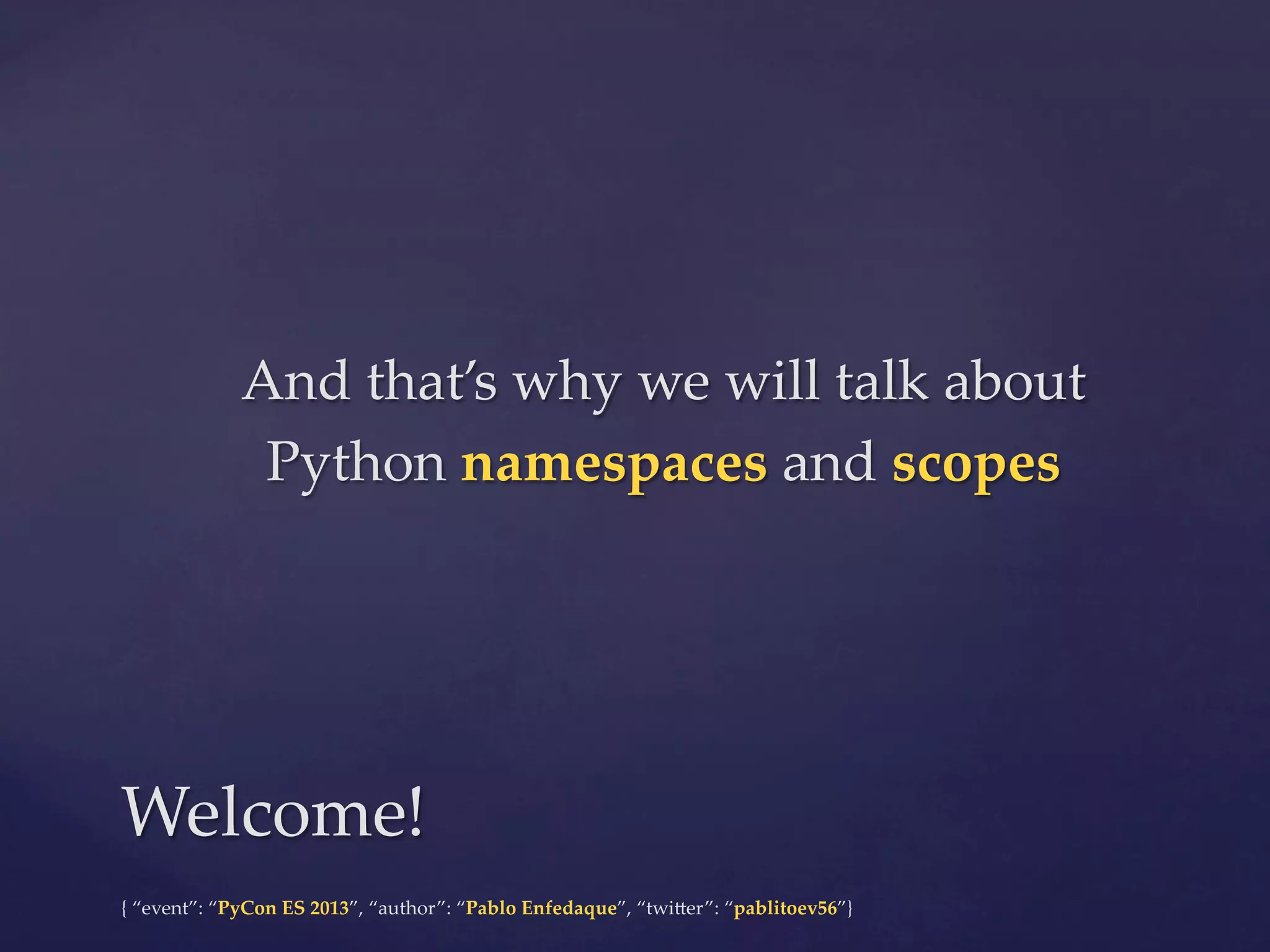


![from collections import OrderedDict
CACHE = OrderedDict()
MAX_SIZE = 100
def set_key(key, value):
"Set a key value, removing oldest key if MAX_SIZE exceeded"
CACHE[key] = value
if len(CACHE) > MAX_SIZE:
CACHE.popitem(last=False)
def get_key(key):
"Retrieve a key value from the cache, or None if not found"
return CACHE.get(key, None)
>>> set_key("my_key", "the_value”)
>>> print(get_key("my_key"))
the_value
>>> print(get_key("not_found_key"))
None
A simple software cache
{ “event”: “PyCon ES 2013”, “author”: “Pablo Enfedaque”, “twi4er”: “pablitoev56”}](https://image.slidesharecdn.com/decoratorsdemystified-131126024636-phpapp02/75/Decorators-demystified-6-2048.jpg)
![def factorial(n):
"Return n! (the factorial of n): n! = n * (n-1)!"
if n < 2:
return 1
return n * factorial(n - 1)
>>> list(map(factorial, range(10)))
[1, 1, 2, 6, 24, 120, 720, 5040, 40320, 362880]
def fibonacci(n):
"Return nth fibonacci number: fib(n) = fib(n-1) + fib(n-2)"
if n < 2:
return n
return fibonacci(n - 1) + fibonacci(n - 2)
>>> list(map(fibonacci, range(10)))
[0, 1, 1, 2, 3, 5, 8, 13, 21, 34]
Factorial and fibonacci functions
{ “event”: “PyCon ES 2013”, “author”: “Pablo Enfedaque”, “twi4er”: “pablitoev56”}](https://image.slidesharecdn.com/decoratorsdemystified-131126024636-phpapp02/75/Decorators-demystified-7-2048.jpg)


![from collections import OrderedDict
CACHE = OrderedDict()
MAX_SIZE = 100
def set_key(key, value):
"Set a key value, removing oldest key if MAX_SIZE exceeded"
CACHE[key] = value
if len(CACHE) > MAX_SIZE:
CACHE.popitem(last=False)
def get_key(key):
"Retrieve a key value from the cache, or None if not found"
return CACHE.get(key, None)
>>> set_key("my_key", "the_value”)
>>> print(get_key("my_key"))
the_value
>>> print(get_key("not_found_key"))
None
How do we access this a4ribute?
{ “event”: “PyCon ES 2013”, “author”: “Pablo Enfedaque”, “twi4er”: “pablitoev56”}](https://image.slidesharecdn.com/decoratorsdemystified-131126024636-phpapp02/75/Decorators-demystified-10-2048.jpg)
![def factorial(n):
"Return n! (the factorial of n): n! = n * (n-1)!"
if n < 2:
return 1
return n * factorial(n - 1)
>>> list(map(factorial, range(10)))
[1, 1, 2, 6, 24, 120, 720, 5040, 40320, 362880]
def fibonacci(n):
"Return nth fibonacci number: fib(n) = fib(n-1) + fib(n-2)"
if n < 2:
return n
return fibonacci(n - 1) + fibonacci(n - 2)
>>> list(map(fibonacci, range(10)))
[0, 1, 1, 2, 3, 5, 8, 13, 21, 34]
How are recursive calls possible?
{ “event”: “PyCon ES 2013”, “author”: “Pablo Enfedaque”, “twi4er”: “pablitoev56”}](https://image.slidesharecdn.com/decoratorsdemystified-131126024636-phpapp02/75/Decorators-demystified-11-2048.jpg)
![>>> from os import path
>>> print(type(path), id(path))
<class 'module'> 4300435112
>>> from sys import path
>>> print(type(path), id(path))
<class 'list'> 4298480008
def split_path(path, sep="/"):
print(type(path), id(path))
return path.split(sep)
>>> split_path("/this/is/a/full/path")
<class 'str'> 4302038120
['', 'this', 'is', 'a', 'full', 'path']
A simpler case
{ “event”: “PyCon ES 2013”, “author”: “Pablo Enfedaque”, “twi4er”: “pablitoev56”}](https://image.slidesharecdn.com/decoratorsdemystified-131126024636-phpapp02/75/Decorators-demystified-12-2048.jpg)
![>>> from os import path
>>> print(type(path), id(path))
<class 'module'> 4300435112
>>> from sys import path
>>> print(type(path), id(path))
<class 'list'> 4298480008
def split_path(path, sep="/"):
print(type(path), id(path))
return path.split(sep)
>>> split_path("/this/is/a/full/path")
<class 'str'> 4302038120
['', 'this', 'is', 'a', 'full', 'path']
The same name defined several times?
{ “event”: “PyCon ES 2013”, “author”: “Pablo Enfedaque”, “twi4er”: “pablitoev56”}](https://image.slidesharecdn.com/decoratorsdemystified-131126024636-phpapp02/75/Decorators-demystified-13-2048.jpg)
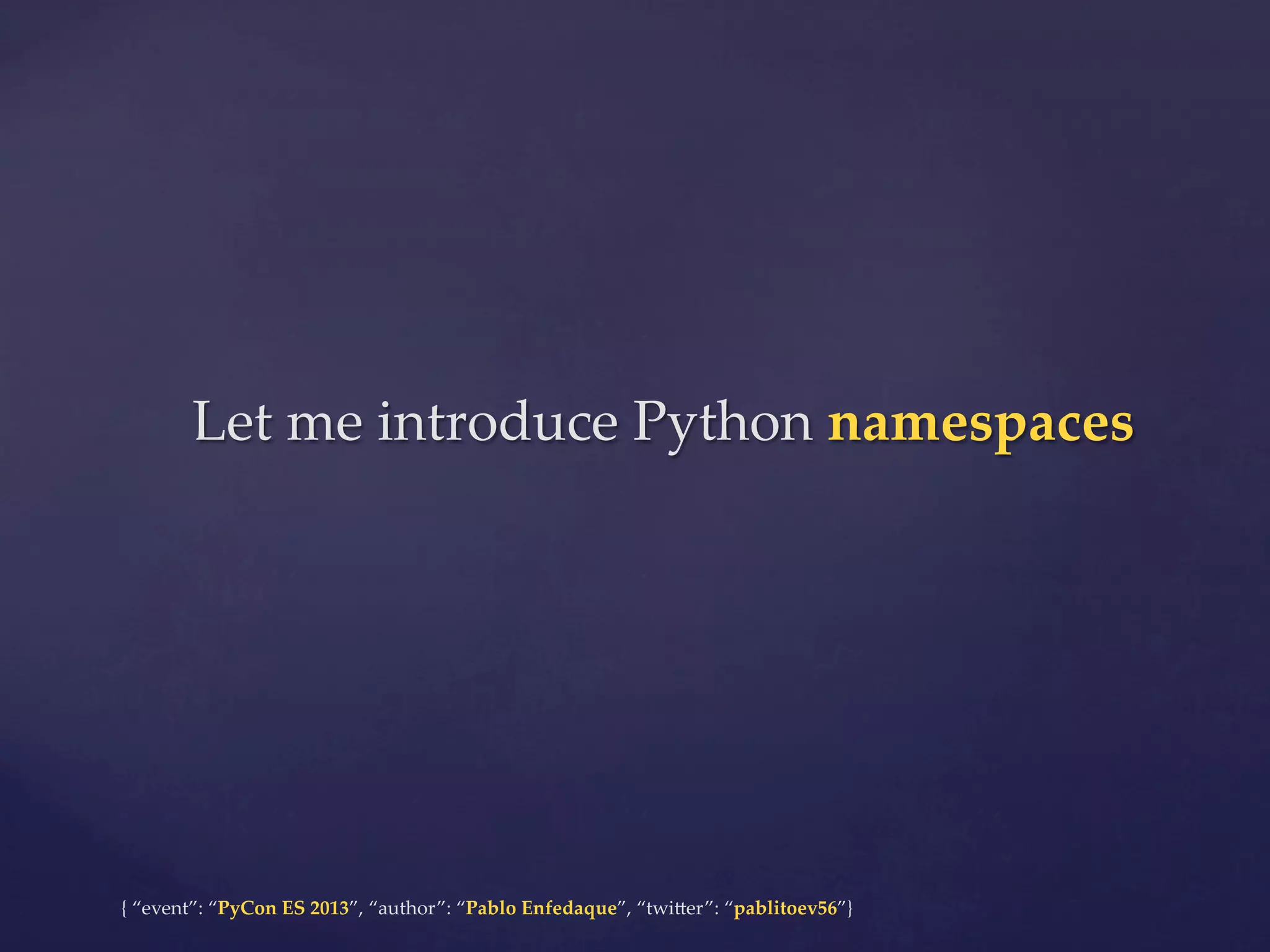
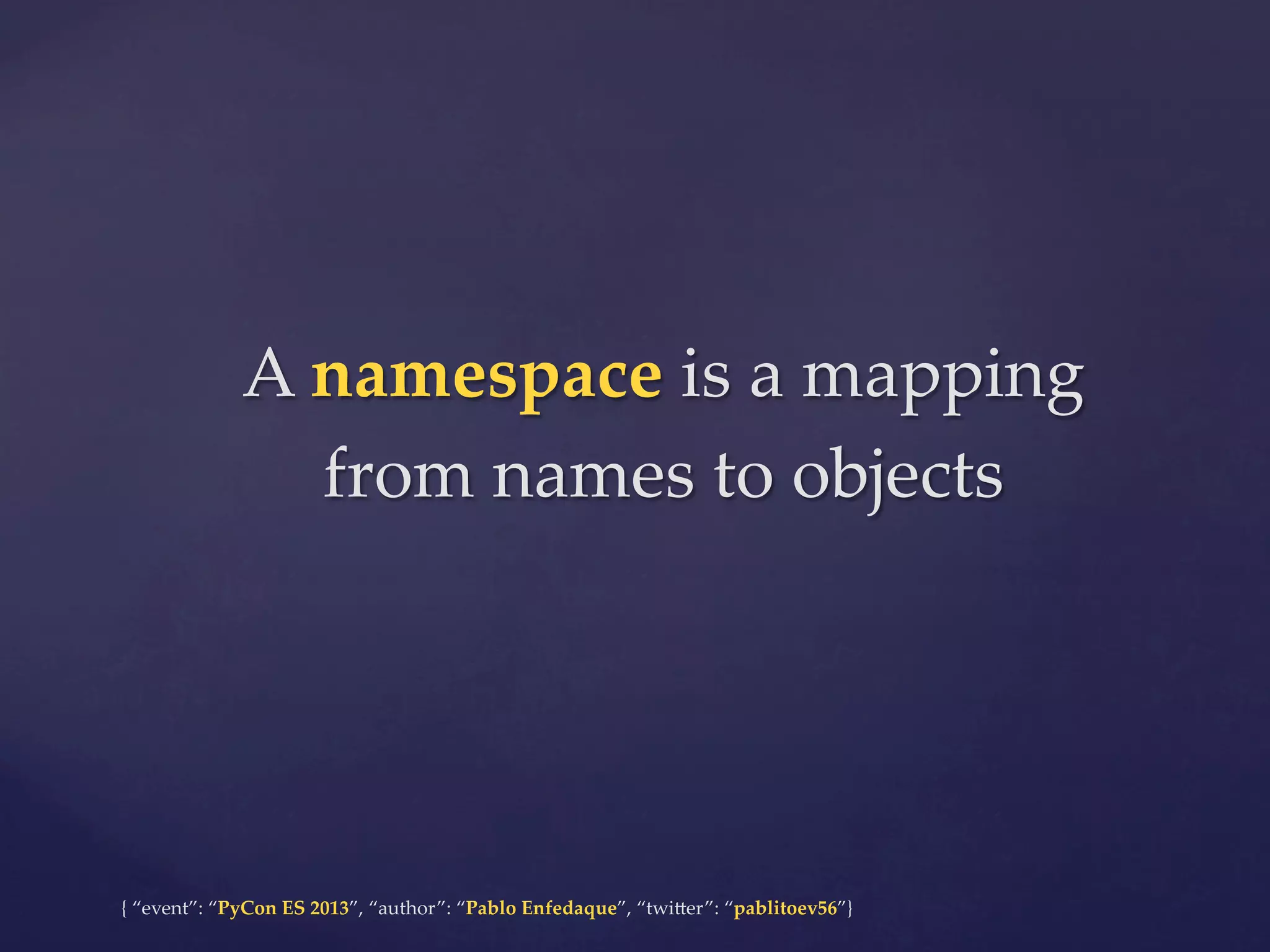
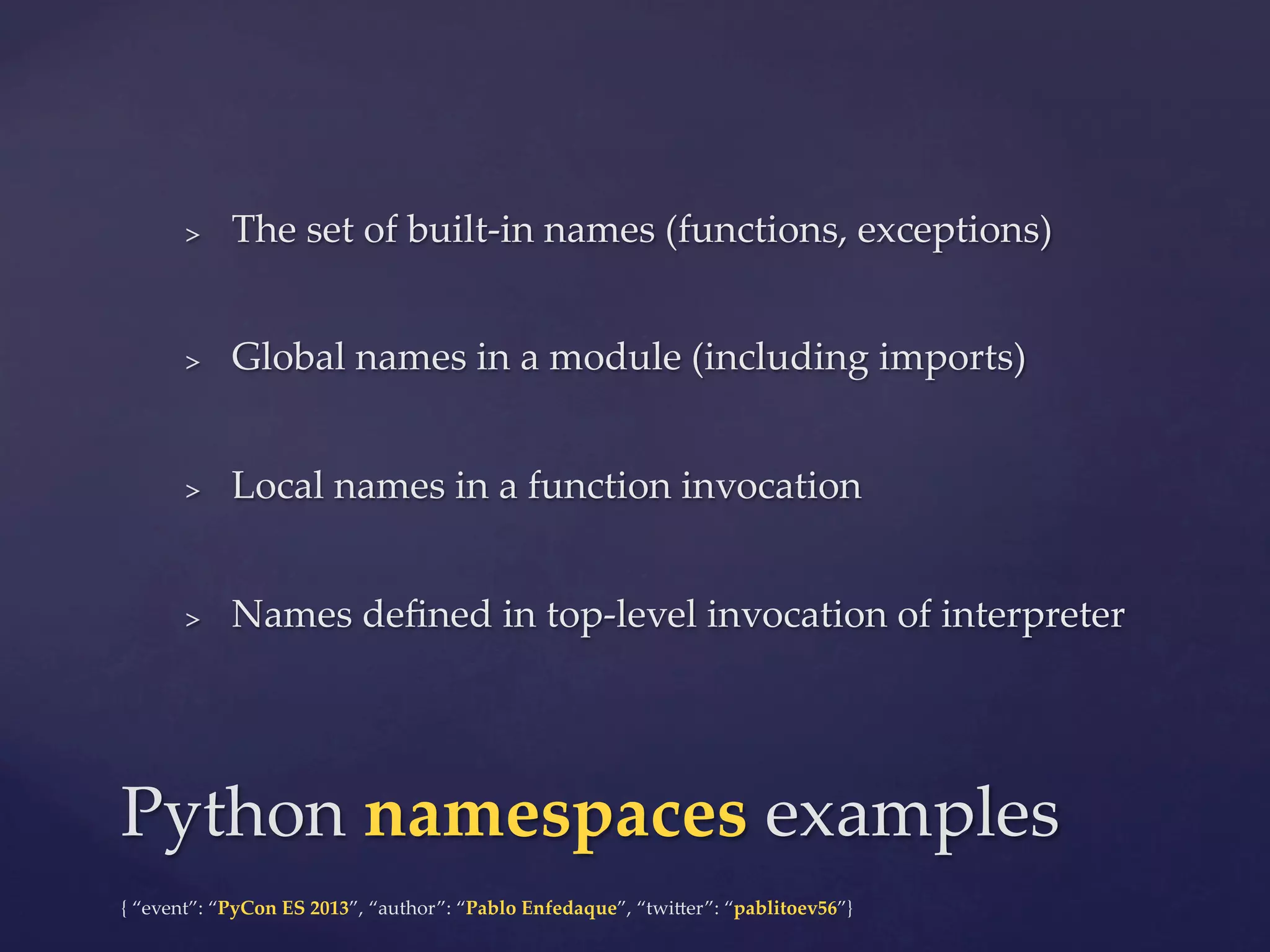
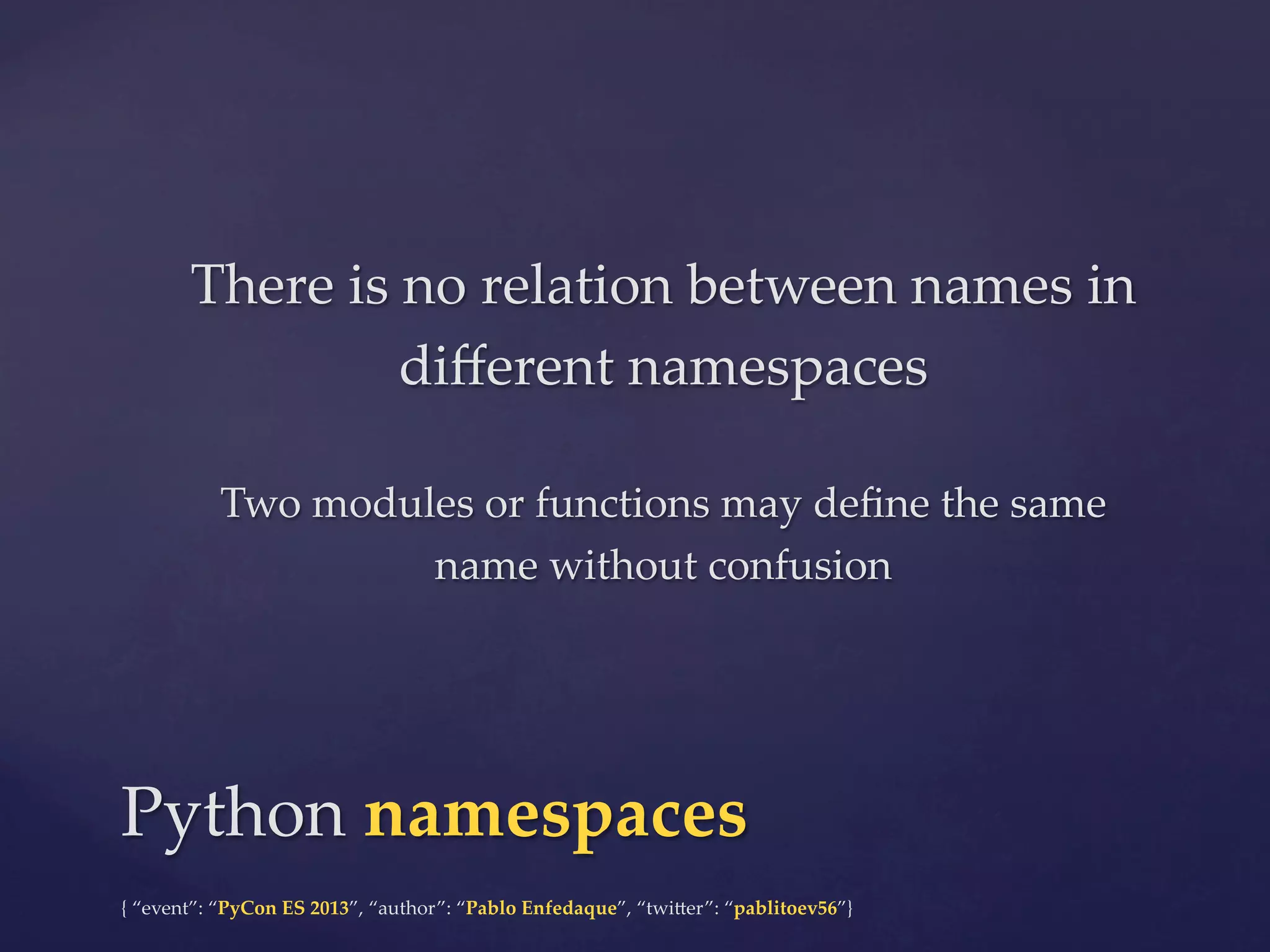
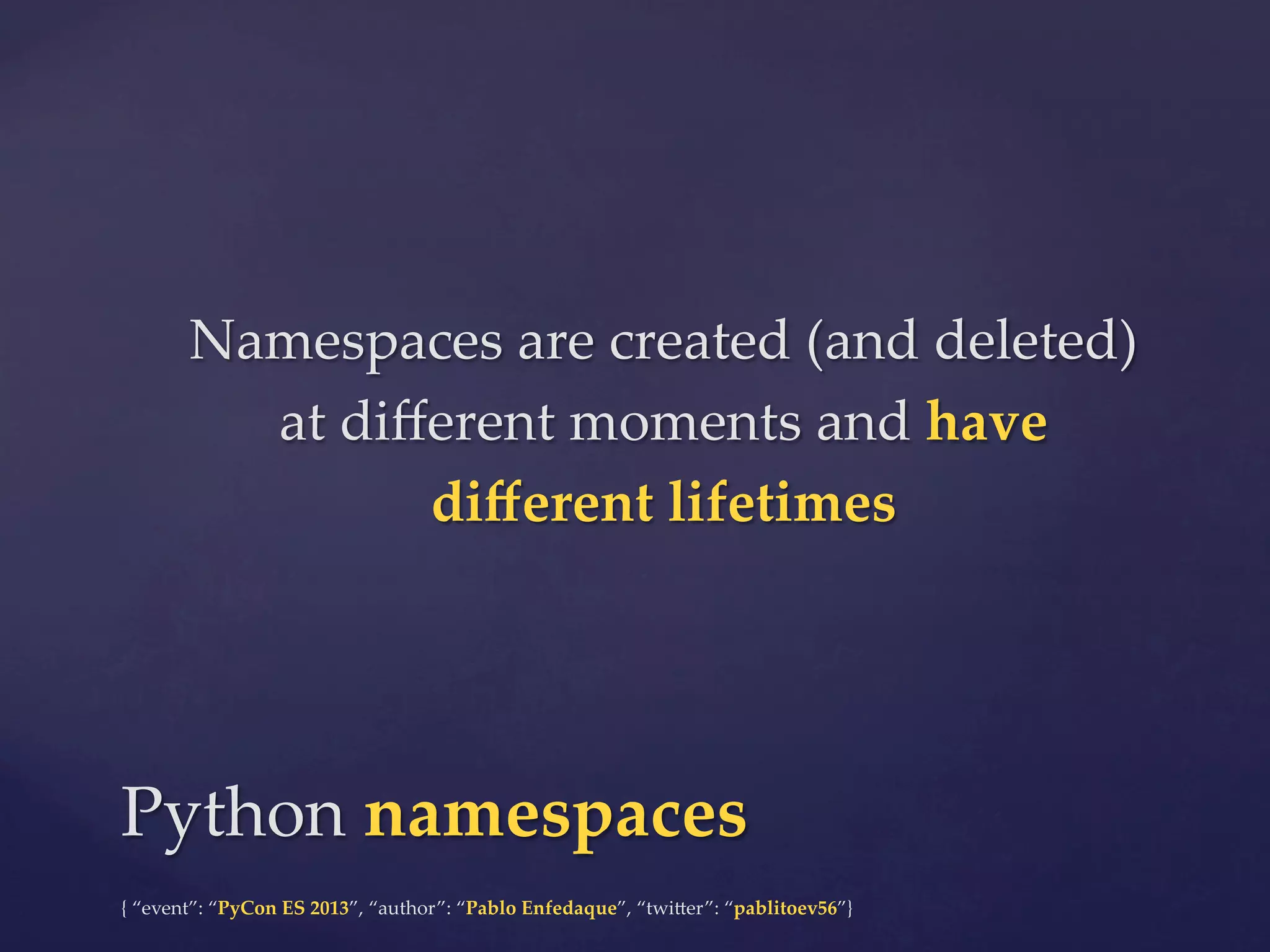
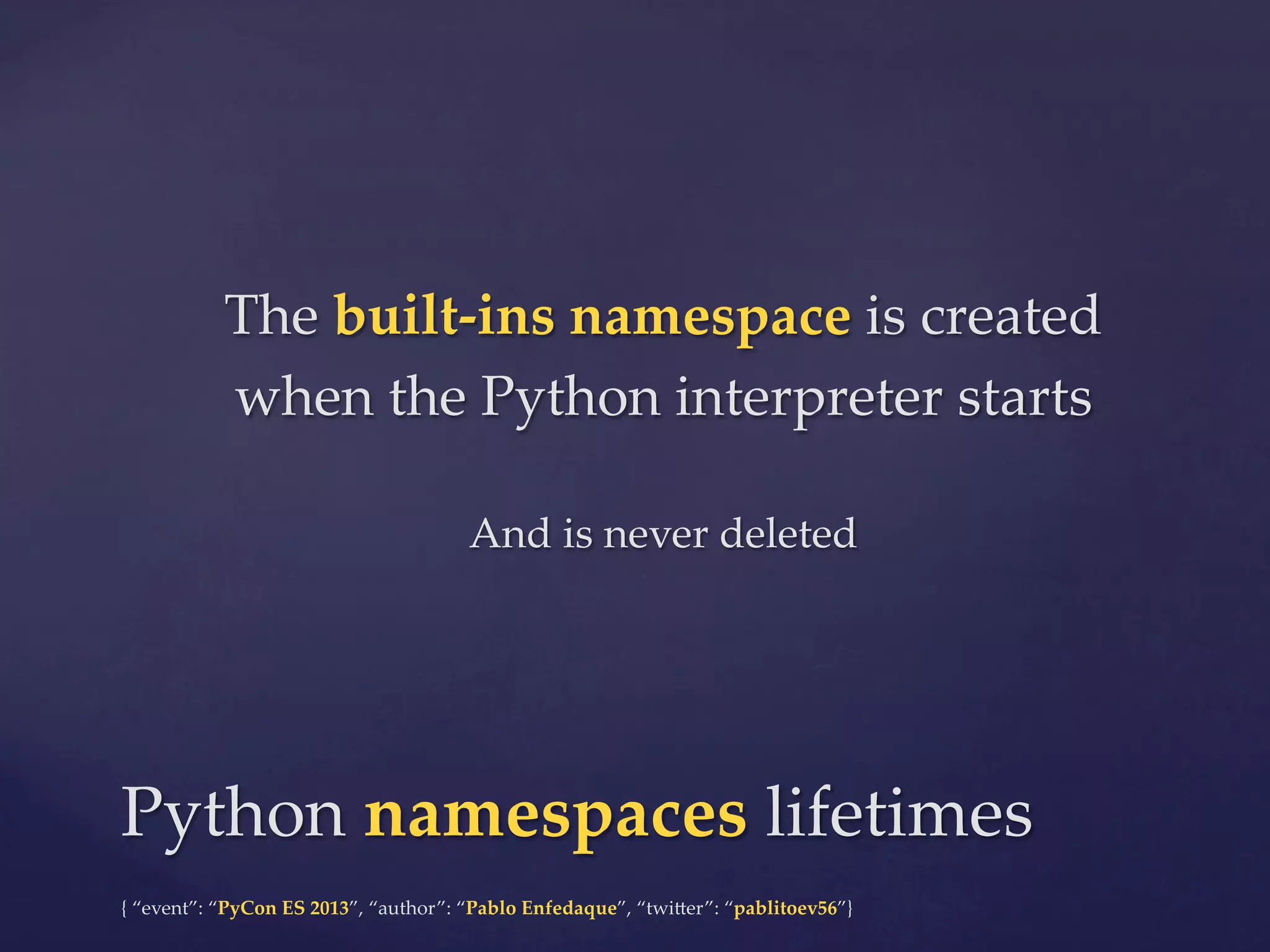
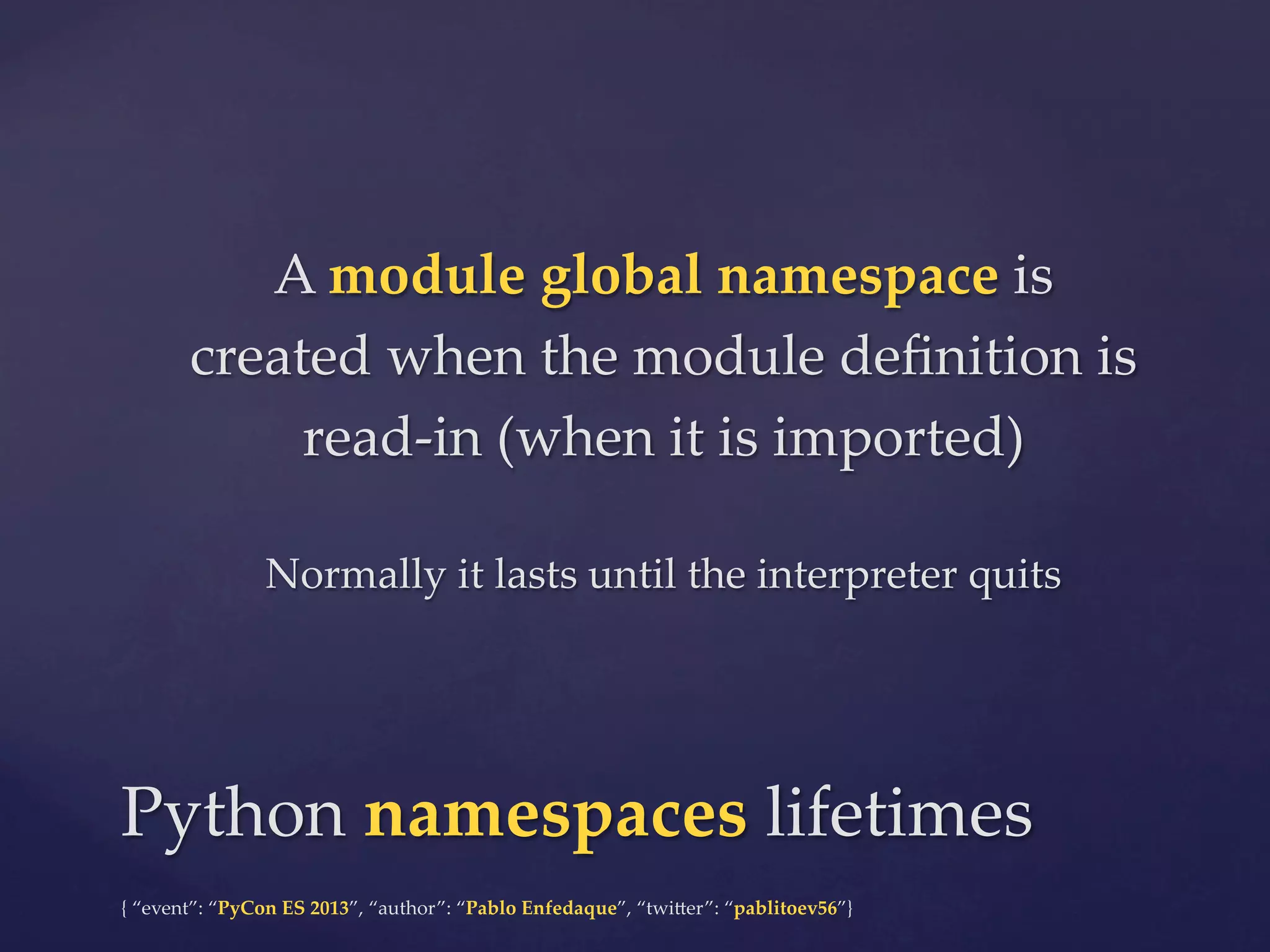
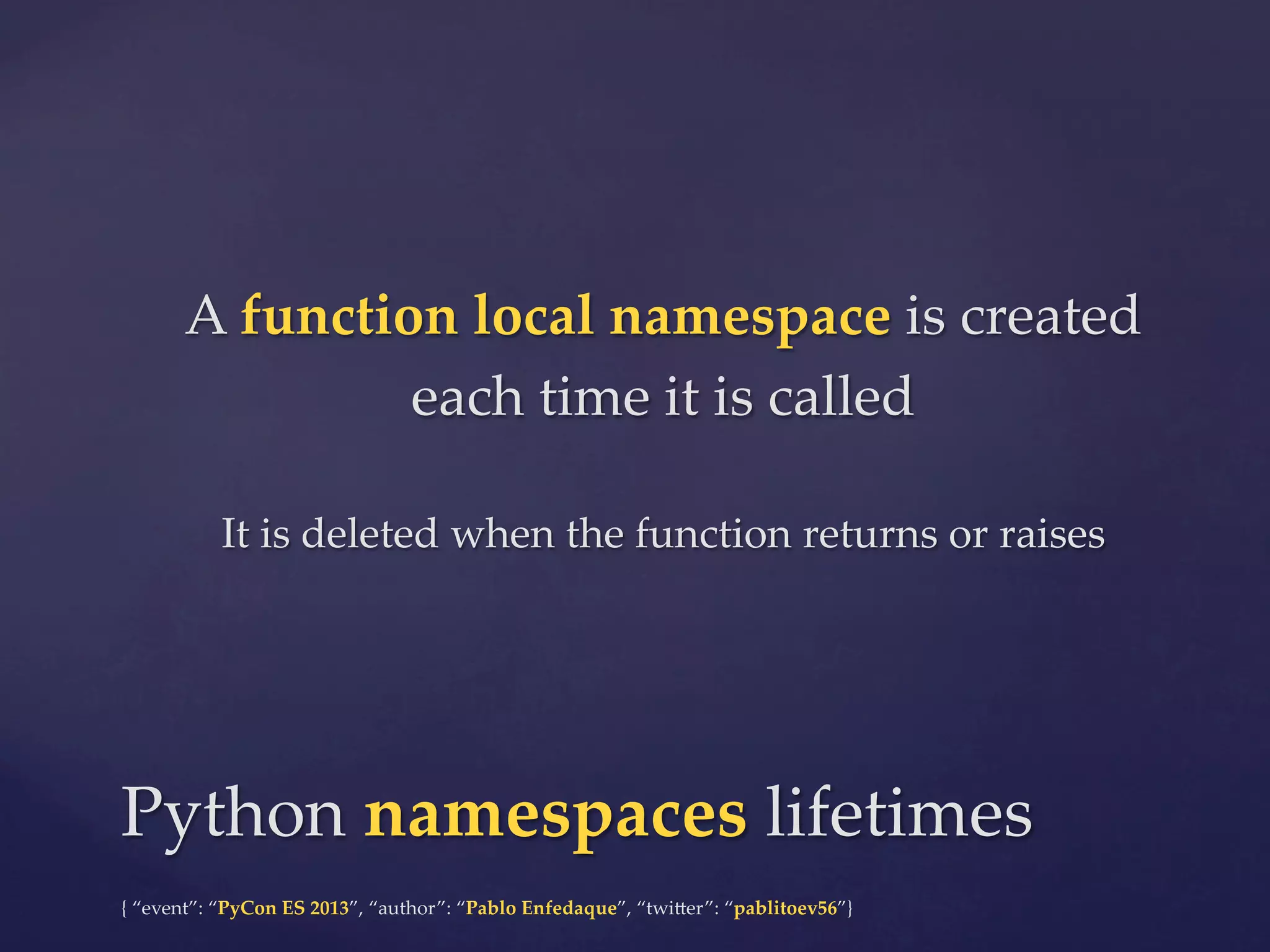
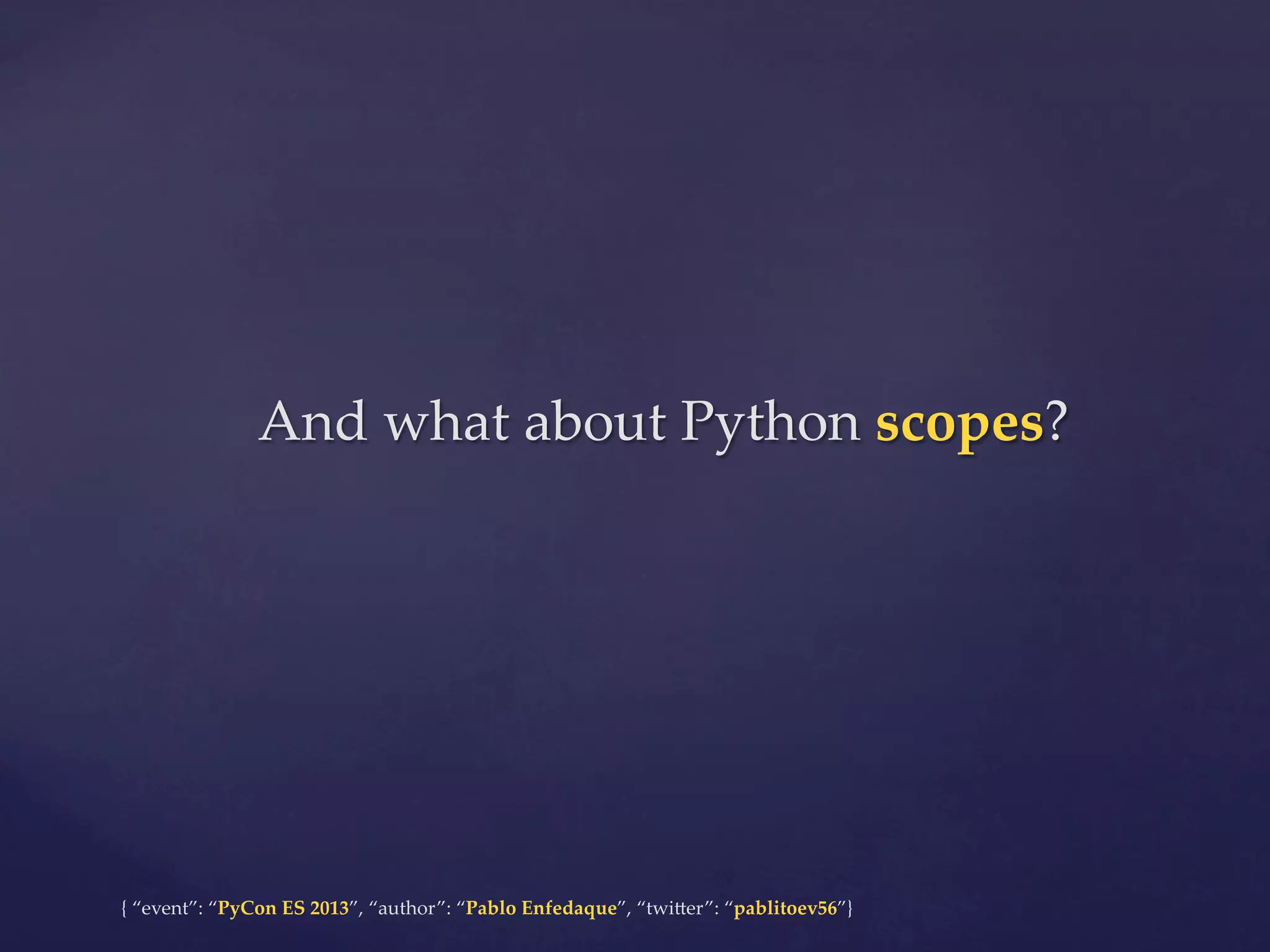

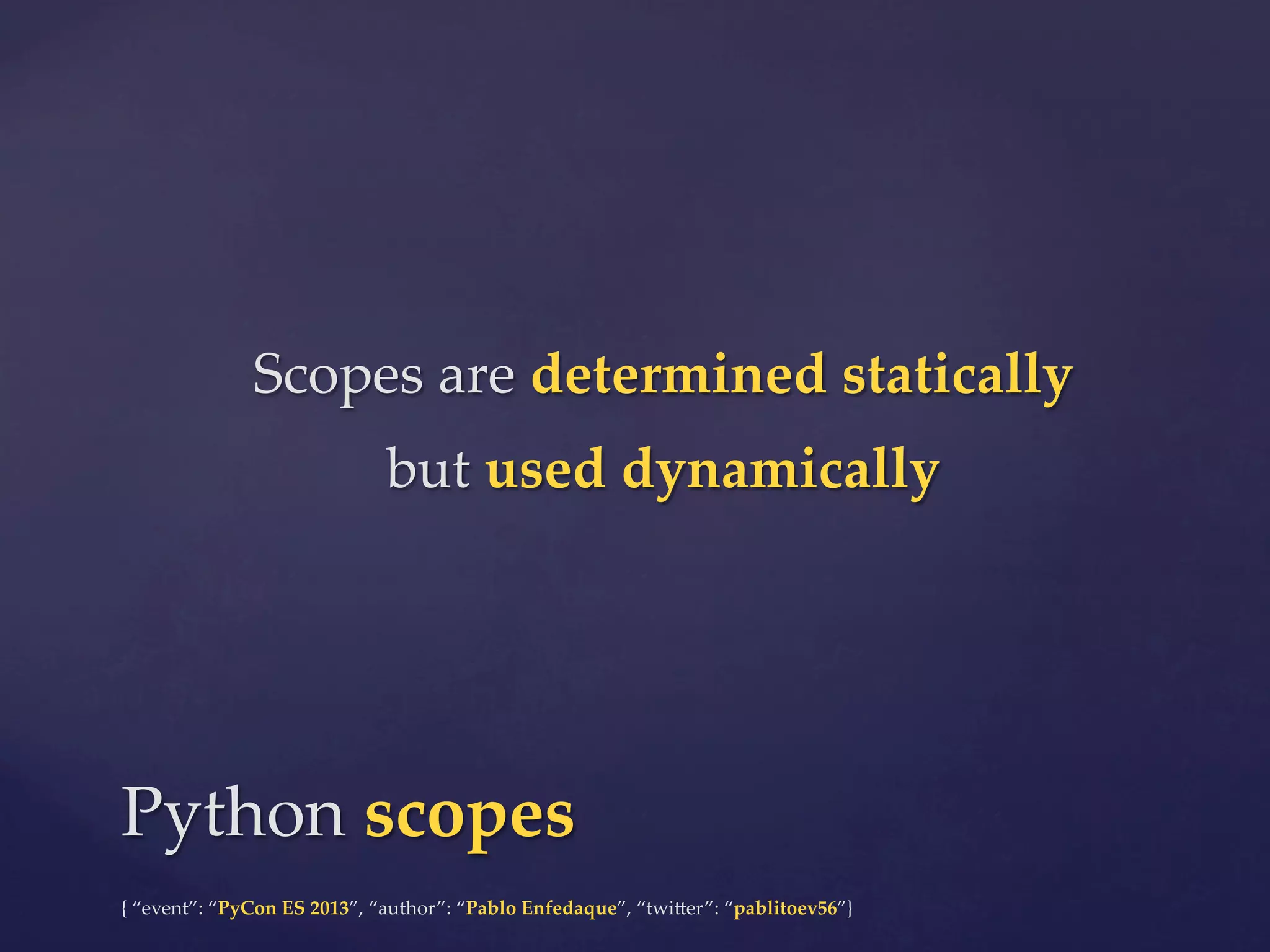
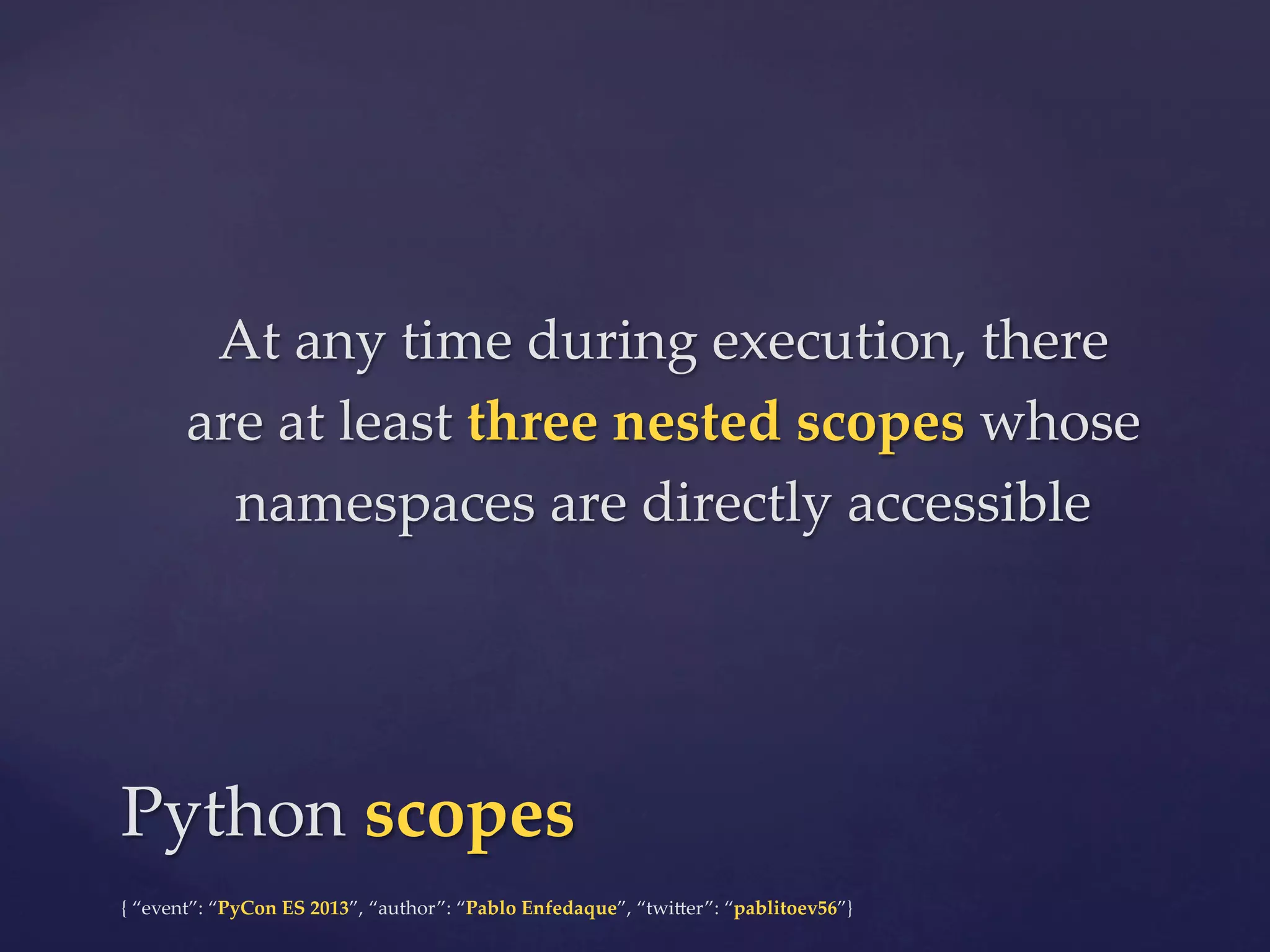

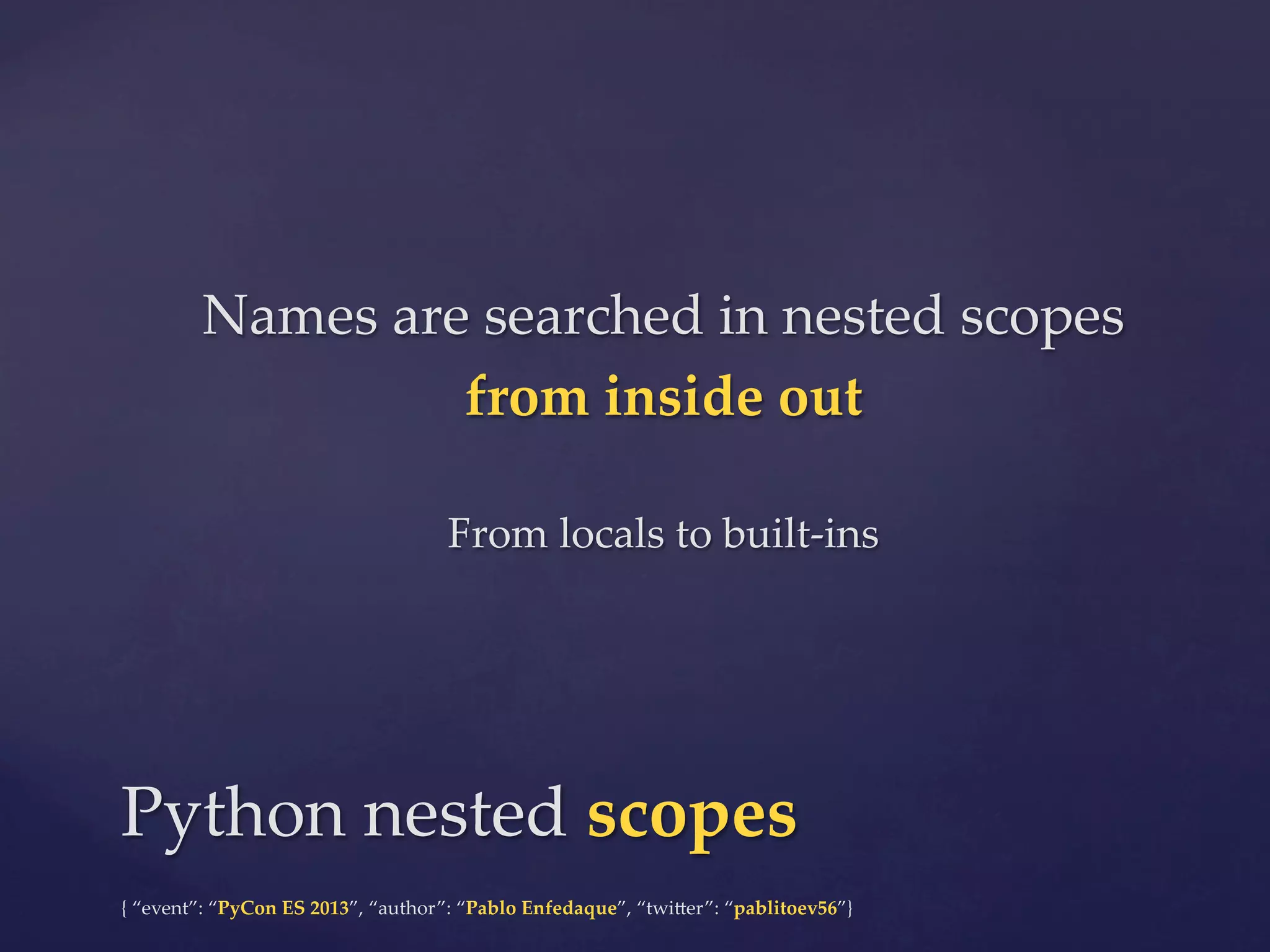
![$ python
Python 2.7.5 (default, Aug 25 2013, 00:04:04)
[GCC 4.2.1 Compatible Apple LLVM 5.0
(clang-500.0.68)] on darwin
Type "help", "copyright", "credits" or "license"
for more information.
>>> import cache
>>> cache.set_key("my_key", 7)
>>> cache.get_key("my_key")
7
>>>
"""
Simple cache implementation
"""
from collections import OrderedDict
CACHE = OrderedDict()
MAX_SIZE = 100
def set_key(key, value):
"Set a key value, removing oldest key if MAX_SIZE exceeded"
CACHE[key] = value
if len(CACHE) > MAX_SIZE:
CACHE.popitem(last=False)
def get_key(key):
"Retrieve a key value from the cache, or None if not found"
return CACHE.get(key, None)
Python scopes
{ “event”: “PyCon ES 2013”, “author”: “Pablo Enfedaque”, “twi4er”: “pablitoev56”}](https://image.slidesharecdn.com/decoratorsdemystified-131126024636-phpapp02/75/Decorators-demystified-28-2048.jpg)
![$ python
Python 2.7.5 (default, Aug 25 2013, 00:04:04)
[GCC 4.2.1 Compatible Apple LLVM 5.0
(clang-500.0.68)] on darwin
Type "help", "copyright", "credits" or "license"
for more information.
>>> import cache
>>> cache.set_key("my_key", 7)
>>> cache.get_key("my_key")
7
>>>
"""
The outermost scope:
built-‐‑in names
The next-‐‑to-‐‑last scope:
Simple cache implementation
current module’s global names
"""
from collections import OrderedDict
CACHE = OrderedDict()
MAX_SIZE = 100
def set_key(key, value):
"Set a key value, removing oldest key if MAX_SIZE exceeded"
CACHE[key] = value
if len(CACHE) > MAX_SIZE:
The innermost scope:
CACHE.popitem(last=False)
current local names
def get_key(key):
"Retrieve a key value from the cache, or None if not found"
return CACHE.get(key, None)
Python scopes
{ “event”: “PyCon ES 2013”, “author”: “Pablo Enfedaque”, “twi4er”: “pablitoev56”}](https://image.slidesharecdn.com/decoratorsdemystified-131126024636-phpapp02/75/Decorators-demystified-29-2048.jpg)
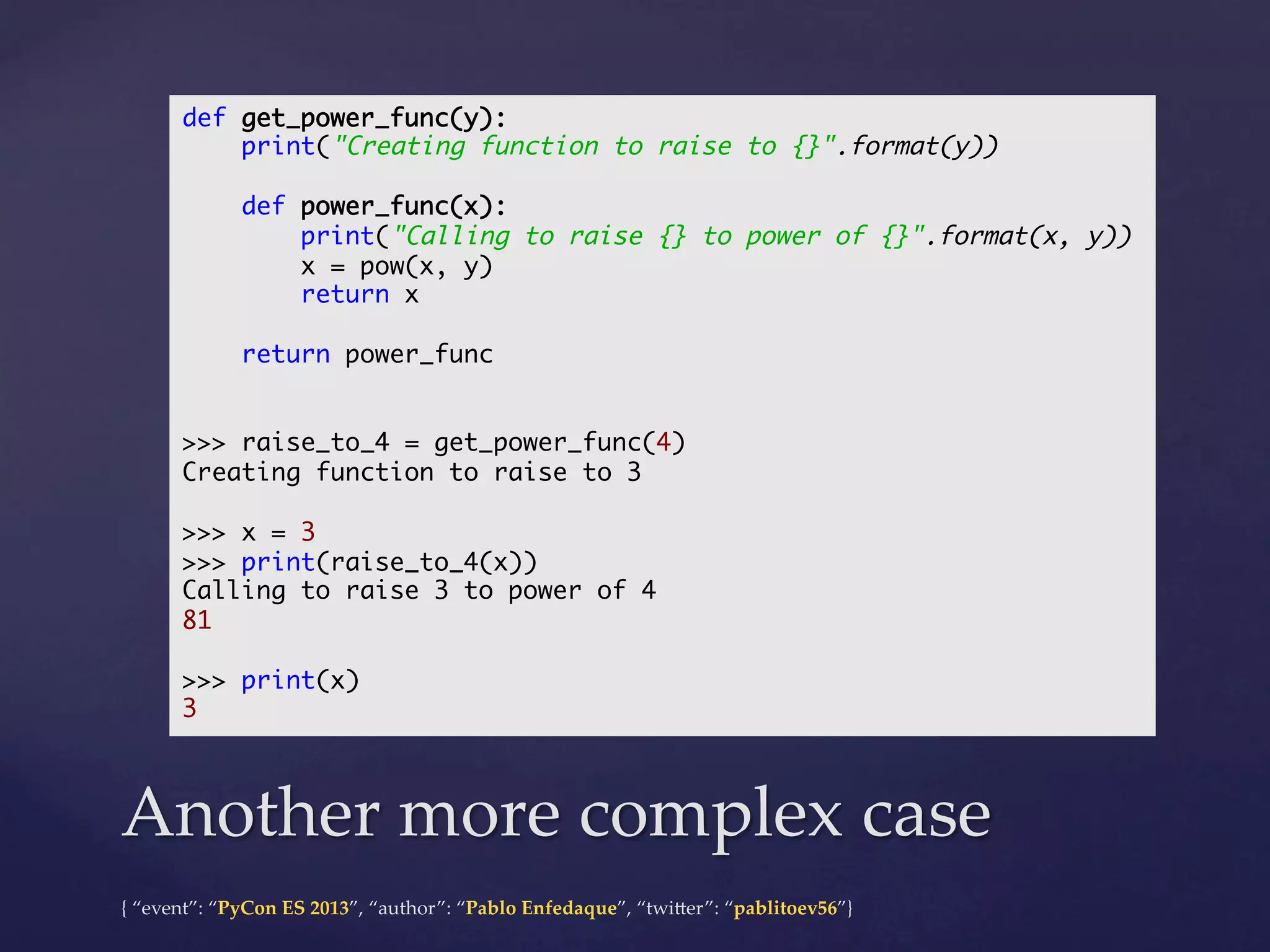


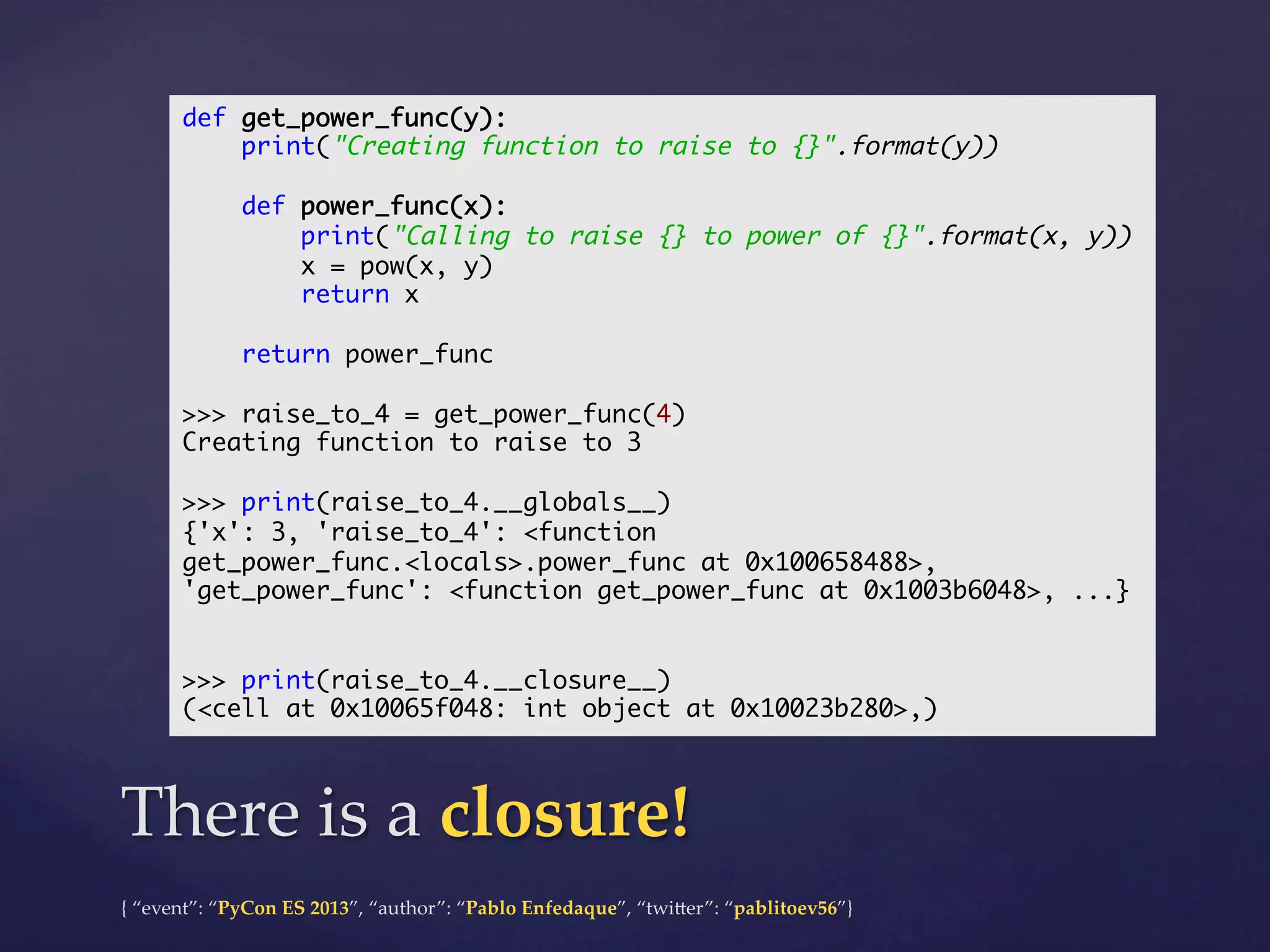
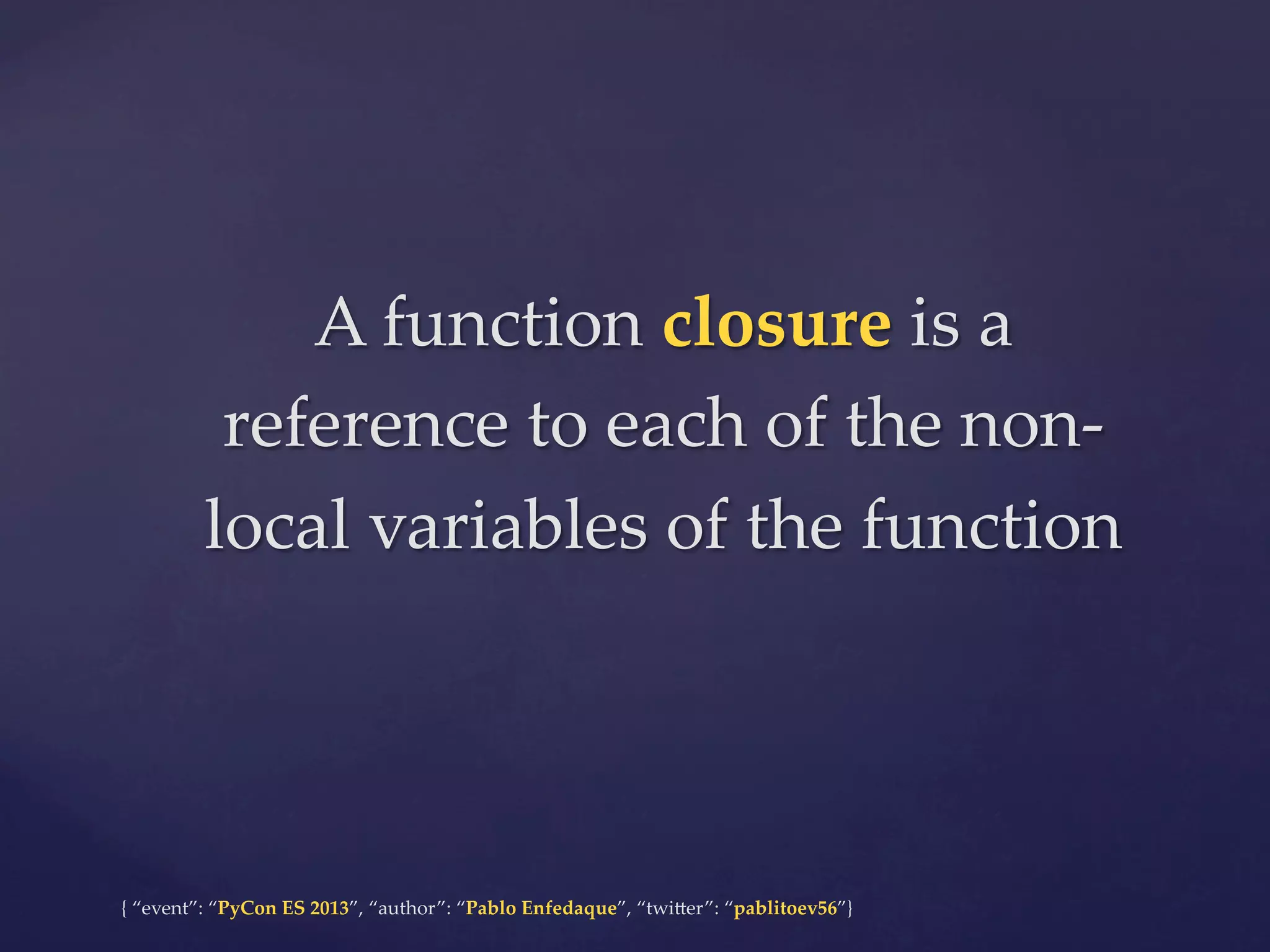
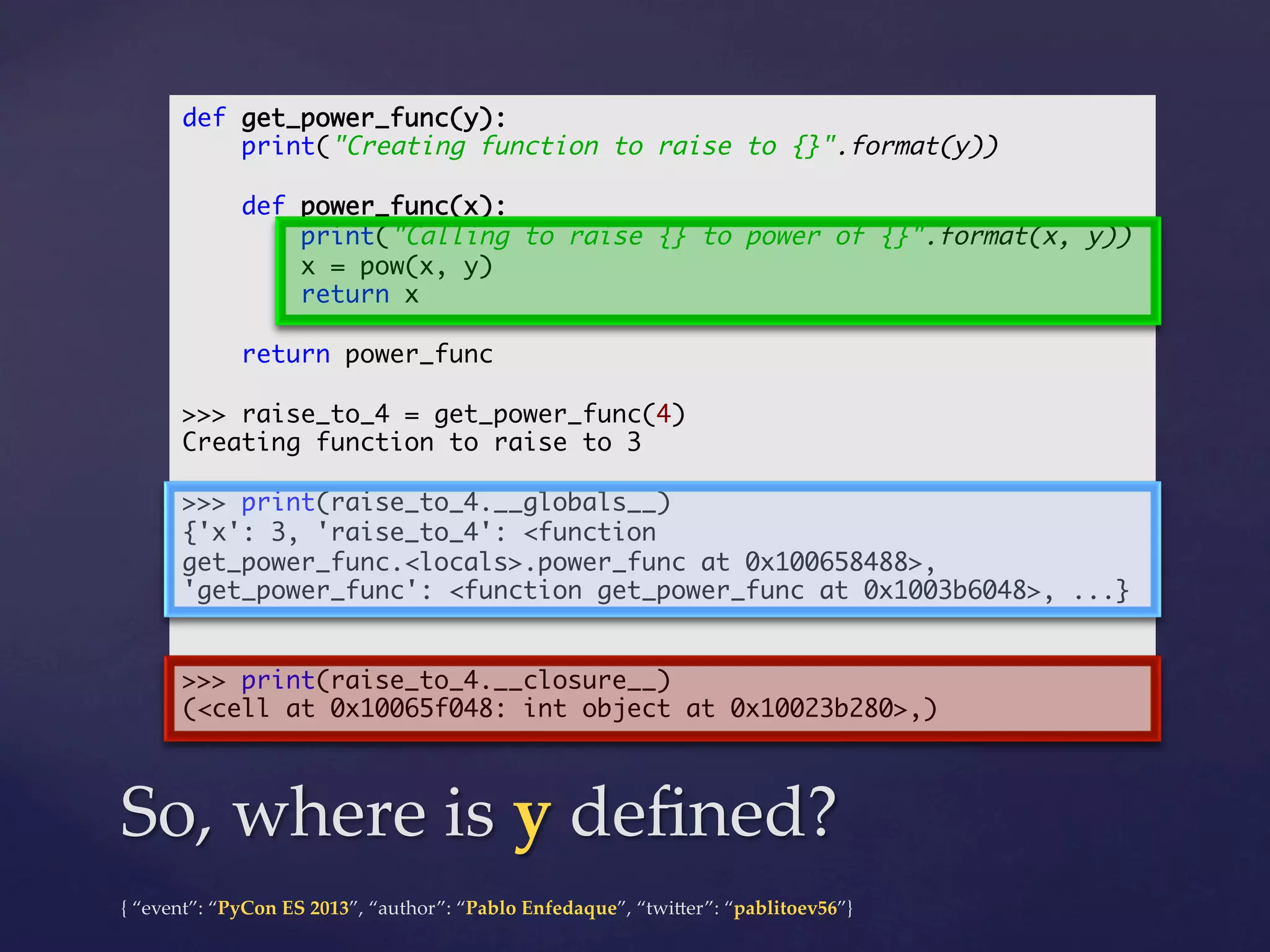




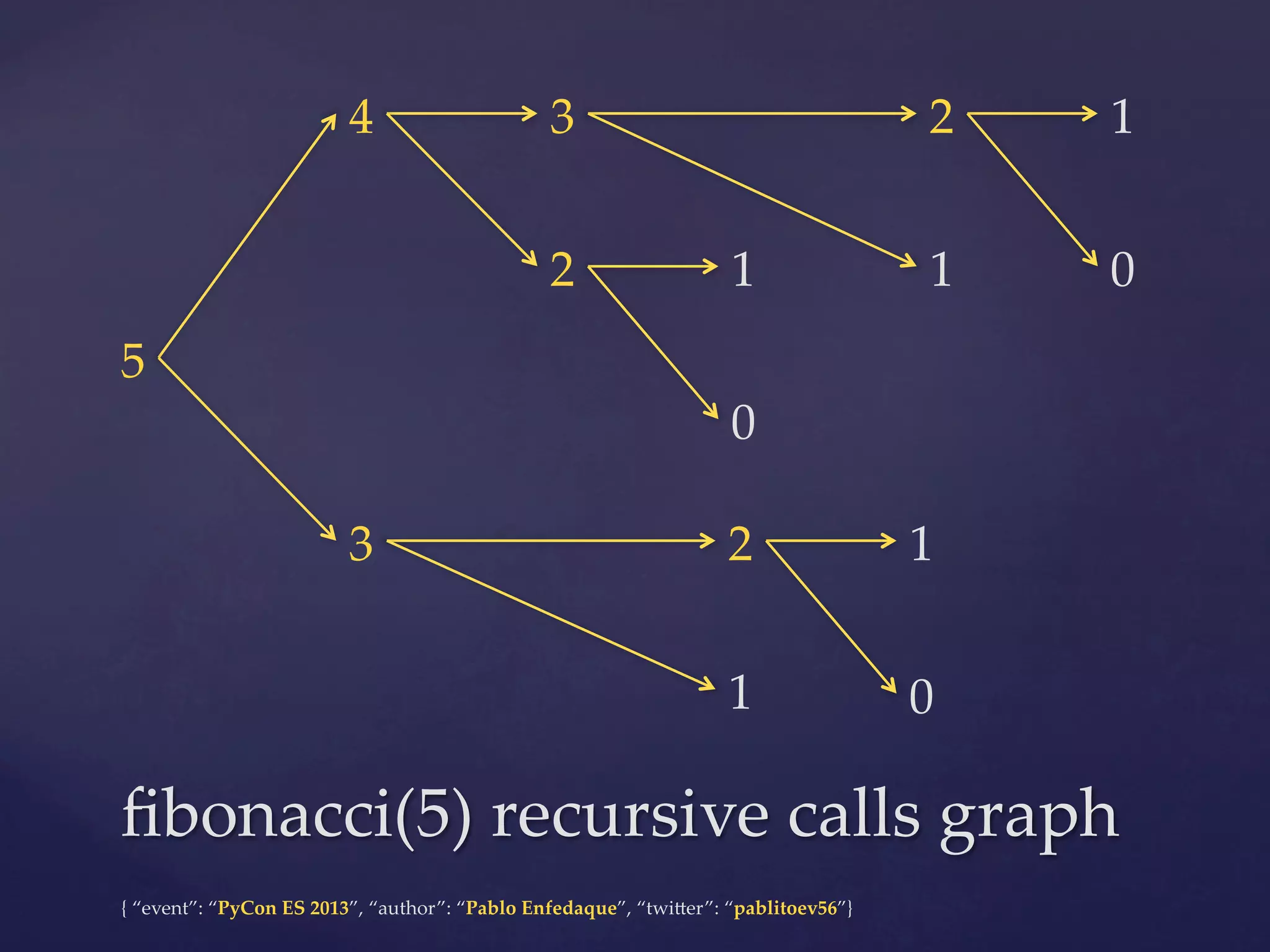
![from collections import OrderedDict
CACHE = OrderedDict()
MAX_SIZE = 100
def set_key(key, value):
"Set a key value, removing oldest key if MAX_SIZE exceeded"
CACHE[key] = value
if len(CACHE) > MAX_SIZE:
CACHE.popitem(last=False)
def get_key(key):
"Retrieve a key value from the cache, or None if not found"
return CACHE.get(key, None)
>>> set_key("my_key", "the_value”)
>>> print(get_key("my_key"))
the_value
>>> print(get_key("not_found_key"))
None
Do you remember we have a cache?
{ “event”: “PyCon ES 2013”, “author”: “Pablo Enfedaque”, “twi4er”: “pablitoev56”}](https://image.slidesharecdn.com/decoratorsdemystified-131126024636-phpapp02/75/Decorators-demystified-41-2048.jpg)


